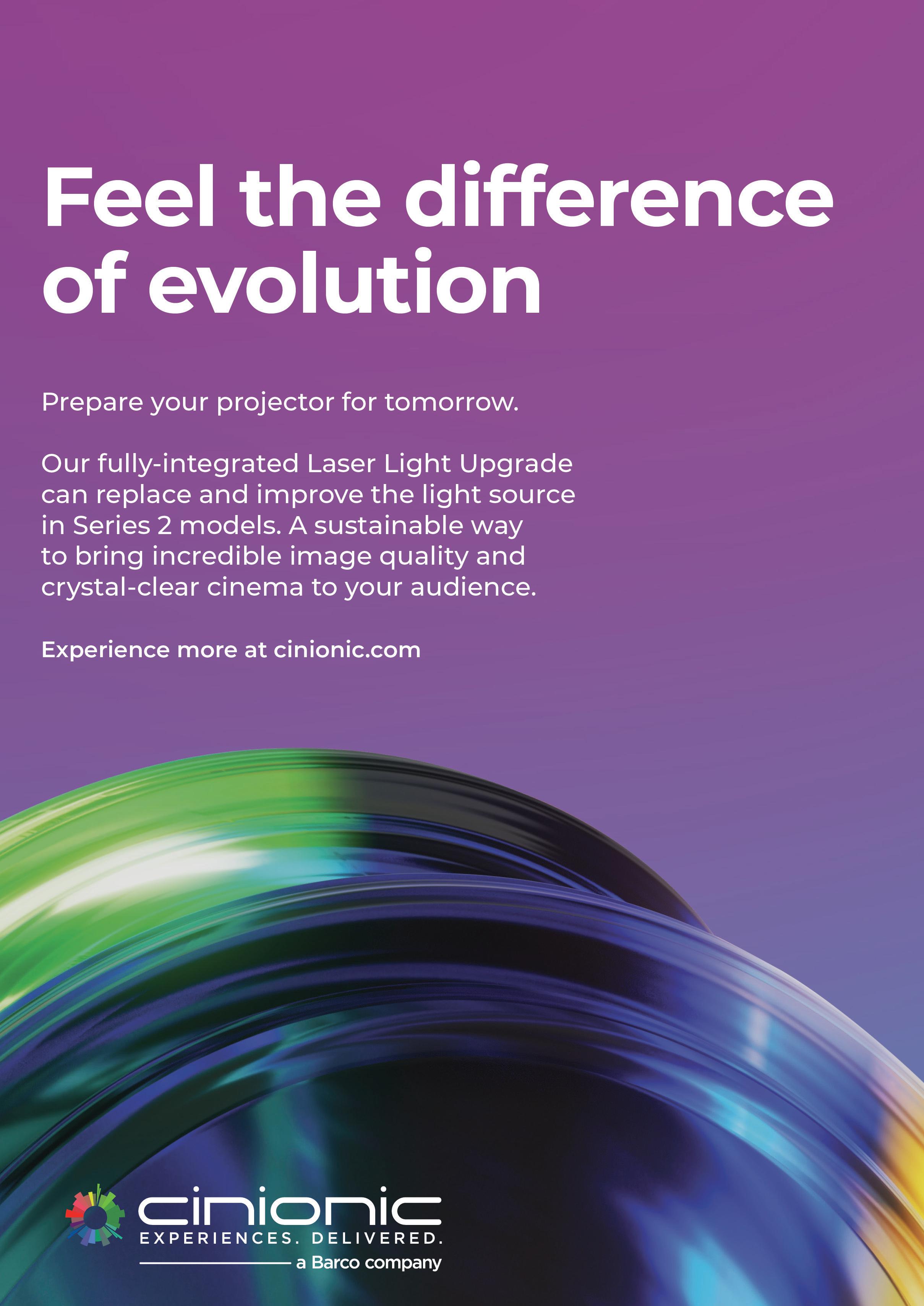70 Years Of Pearl and Dean

A look back at cinema pioneers.

70 Years Of Pearl and Dean

A look back at cinema pioneers.
Exploring the enormous success of the summer's two big box office hits

Hasn’t it been a great few months?
It’s been so positive that even media and news
outlets have begrudgingly had to admit what we already knew, that cinema isn’t dead, it is in fact alive and kicking!
The positivity has been growing all year, backed by a terrific slate and what feels like a cohesive industry movement to bring movie-goers back to the big screen. The excitement and upbeat mood we all felt coming away from CinemaCon translated in to an incredibly positive and productive Cine Europe where it felt as though the European industry in particular addressed and came up with some solutions for a few of the pressing issues we face, from staffing and education through to sustainability – see pages 54 and 55.
That tidal wave of positivity then saw us land head first in to Mission Impossible and then in to the global phenomenon where the combined marketing efforts of
studios and exhibitors (along with the pull of the brilliant Christopher Nolan) produced ‘Barbenheimer’, and we all know how that story has worked out! And that rolled nicely in to a number of highly successful national cinema days driving further admissions.
There are of course challenges on the horizon, the writers’ strike being a pretty major one, but the industry has its swagger back with Taylor Swift about to make a big splash at the box office too, who could have predicted that? Long may it continue.
But as my friend and colleague Markus Overath rightly pointed out in our June edition, we have to keep working together and focus on investing now with the future in mind. In this issue we have a diverse range of content that looks at the successes of the marketing effort behind Barbie and Oppenheimer and the take aways that perhaps might lead to more successes, we review the new LED screen technology from LG whilst also taking a look at traditional screens and their role


in optimising laser projection installs. We also take a peek at OneView from Vista that promises to power exhibitors decision making from the power of a mobile device, hear from our podcasters on the thorny issue of aspect ratios and getting presentations right, share updates from partner associations highlighting their incredible work in areas such as accessibility and we celebrate major milestones of Pearl and Dean, Cinionic and indeed CTC!
Onwards my friends! Keep up the amazing work!
Richard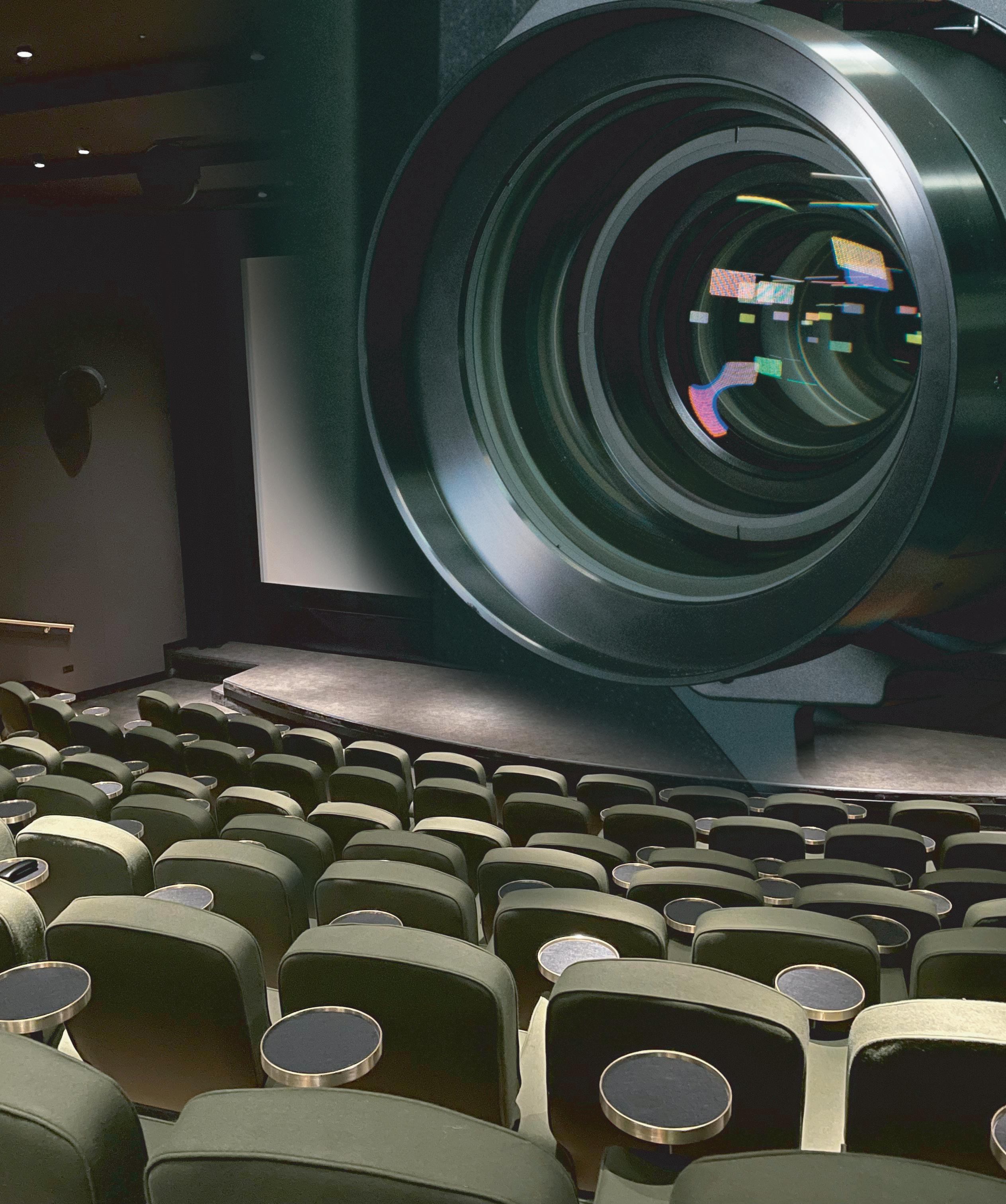
As Pearl and Dean celebrate their
Cinema Technology Community (CTC) 124 City Road London
EC1V 2NX
E: info@cinema-technology.com

CTC PRESIDENT: RICHARD MITCHELL

E: richard.mitchell@cinema-technology.com
36
Why the screen should be an important part of any laser projection upgrade .
42
Five years on from the inception of Cinionic, we catch up with CEO Wim Buyens.

44
A look at the new Miraclass LED screen from LG showcased at CineEurope 2023.
46
The CTC podcast team discuss the importance of aspect ratios with cinematographer Nic Knowland.
52
We learn about OneView, the new mobile app from Vista brings together data from their ecosystem.
SPOTLIGHT
Sandie Caffelle talks to Helena Young and Wendy Nam and learns about the iconic Shaw Studios and Theatre in Hong Kong.
48
ART DIRECTOR: DEAN CHILLMAID
E: dean.chillmaid@cinema-technology.com
COMMISSIONING EDITOR: PETER KNIGHT

E: peter.knight@cinema-technology.com
ADVERTISING: ADVERTISING TEAM
E: magazine.advertising@ cinema-technology.com
SUBSCRIPTIONS
Cinema Technology is mailed to IMIS Members. For subscription details and to read the magazine online, visit www.cinematechnology.com or email peter. knight@cinema-technology.com




CHRISTIE® recently announced it has signed a multiyear agreement to supply its RGB pure laser projectors to Cineplex Germany. Work is underway to install RGB pure laser projectors as part of the agreement, which will operate until 2026. The RGB pure laser projectors will replace long-serving Christie Xenon-illuminated Series 1 and Series 2 projectors. Cineplex Germany operates more than 90 theatres – with over 560 screens – and is the largest cinema operator in the country, encompassing 26 family-owned cinema operations.
“We are pleased to continue the good partnership, which was established in the analogue era and consolidated in the digital age of film projection. And now in the laser era, we continue within the framework of long-term cooperation,” says Kim Ludolf Koch, general manager, Cineplex Germany. “Christie has proven to be a fair partner for the heterogeneous needs of the 26 Cineplex family businesses. We are
pleased to be able to present our customers with the perfect image of the high-quality, economical and powerful projectors from Christie.”
Christie’s RGB pure laser cinema projectors with Real|Laser™ illumination technology output more lumens per watt than the competition, with long-lasting light sources for more than 50,000 hours of DCI-specified onscreen brightness and the highest operational efficiency in the market.
“We’re thrilled that Cineplex has chosen Christie’s industry-leading cinema projection solutions as it takes a leap forward with RGB pure laser technology,” says Adil Zerouali, senior sales director, Cinema EMEA, Christie.

“We have enjoyed an excellent working relationship for many years. It’s pleasing to see this continue. It’s clear that both Christie and Cineplex strive to deliver the most exceptional cinematic experiences to audiences.”
Chicagoland’s Award-winning Cinema Circuit to Upgrade Its Legacy Media Servers with GDC’s Ultra-Reliable SR1000 Integrated Media Block
GDC Technology Limited, (GDC) a leading global provider of digital cinema solutions, announced today it has signed an agreement with Classic Cinemas to be the exclusive provider of digital cinema media servers. Classic Cinemas is one of the domestic theatre circuits listed in the Boxoffice “Top 50 Giants of Exhibition” and operates 137 screens at 16 sites in the Chicagoland area. The agreement involves the full replacement of legacy media servers with the GDC SR-1000 Standalone Integrated Media Block™ with 4K resolution and GDC’s Enterprise Storage at all Classic Cinemas. The installation will be facilitated by in-house technical services, which will also provide services for the duration of the agreement.
Classic Cinemas is a family-owned
business that opened its first multiplex in 1978 and known for its guest-friendly policies. Since its inception, the company has continually invested in the latest innovations in picture and sound technologies to provide the best possible moviegoing experience at all its cinemas, such as their XQ premium experience auditoriums featuring DTS:X for IAB immersive audio with 4K RGB Laser projection. This agreement provides Classic Cinemas with digital cinema media servers designed with the latest and most powerful technology for nearzero maintenance, ensuring Classic’s guests an uninterrupted experience.
“Since the first day of operations, we have based our partnerships on trust and reliable performance of a company’s products. We firmly believe GDC is one of
the most trusted names in the cinema industry with the most innovative and reliable products,” said Chris Johnson, CEO of Classic Cinemas. “It was not a difficult decision to select GDC’s media server for content playback.”
“Classic Cinemas is a classic example of how to run a cinema circuit,” said Patrick Artiaga, senior director, business development for GDC Technology (USA) LLC. “We are honored to be a preferred partner with one of the most innovative cinema circuits in the country. By selecting GDC for their content playback, Classic Cinemas will always have the latest technology due to our firmware is field upgradable to help them achieve their mission of offering the best entertainment experience for their guests throughout the Chicagoland area.”
ARTS Alliance Media (AAM), the global leader in digital cinema software and services, has announced a new Lifeguard partnership with Total Cinema Solutions LLC (TCS), a United States-based cinema technology integrator for small and independent exhibitors, to enable full integration with their popular TechSelect service. Combining Lifeguard, AAM’s versatile Hardware Management System, with TCS’ TechSelect, a specialised support service that measures the health of assets and software, exhibitors can expect a high-quality site monitoring solution that delivers real-time reports and the skills of a trained technician.
After receiving a custom provisioned appliance from TCS, that device will monitor the performance of an exhibitor’s projection system, collecting data on the health of
projectors, servers, and audio processors, before relaying that information back to Lifeguard to cross-reference with optimum operating parameters. If the data collected does not meet the required standards, TCS technicians will receive an alert to resolve any issues relating to the flagged equipment.
“By partnering with AAM, our esteemed TechSelect service can harness Lifeguard’s full monitoring capabilities and alert procedures to provide a first-class ‘boots on the ground’ solution,”explained Brian Vita, Sales/Svc Manager at Total Cinema Solutions. “This unified package will enable 24/7 access to a qualified technician, helping to maintain the health of their hardware while reducing the risk of failed shows.”
A cloud-based monitoring and
management platform, Lifeguard provides exhibitors and integrators with critical intelligence to help optimise hardware and reduce the cost of operations. With over 40 intelligence reports, automated lamp alerts, and proactive equipment maintenance, exhibitors can optimise resources to make dayto-day theatre management smooth and error-free.
Peter Kim, Global Sales Director at Arts Alliance Media, added, “our ultimate goal is to help exhibitors build efficiency in their operations. By integrating with TCS’ progressive TechSelect service, independent cinemas across the United States can rely on a resourceful, end-to-end NOC solution that will go the extra mile in preventing and resolving issues.”
ARTS Alliance Media (AAM), a global leader in digital cinema software and services, and Microcine, an Italian cinema technology integrator, recently announced the first deployment of Screenlighter in Europe at Tivoli Cinema in Bologna, Italy.
Following the news of multiple installations across the United States, Screenlighter, a Theatre Management System (TMS) designed solely to meet the operational requirements of independent and 1-4 screen cinemas, will help Tivoli Cinema manage content and devices more effectively at their two-screen location, a site that boasts one indoor studio and one summer arena.
“Thanks to the NextGeneration EU recovery
fund contribution for energy efficiency, we had the opportunity to invest in a practical TMS that could help us better manage our content and summer exhibitions in our outdoor arena”, explained Davide Sotiropulos, Manager at Tivoli Cinema.

“Screenlighter’s single interface has proved to be immediately intuitive for our group of volunteers which has reduced the difficulty of learning new systems,” he adds.Facilitating playlist creation, on-screen content control, reporting, and real-time site monitoring, Screenlighter enables cinemas to evolve from manual operations to centralised screen, content and KDM management. With intuitive navigation, drag-and-drop playlist creation, and a light-mode UI that offers clear distinction from existing entrylevel TMS solutions, exhibitors can embrace a refreshing and effortless software experience. As light in data size as it is in appearance, AAM’s new TMS package will easily install on cinemas’ existing hardware, meaning exhibitors can retain their
current infrastructure to avoid unwanted equipment costs and enjoy simple, stress-free setup. Reinforced with a network of integrators, an experienced Support team, and a more advanced TMS upgrade in Screenwriter, AAM are on-hand to provide cinemas with a scalable framework for growth.
“Screenlighter was proposed to Tivoli Cinema because it’s the most suitable TMS to power a small cinema”, said Elia Orselli, Cinema Engineer at Microcine. “With Screenlighter, the operators can easily create playlists for both projection systems and guarantee show punctuality, even in the event of rain throughout the summer.”
Roberto Marabotto, Global Account Director at Arts Alliance Media, added, “we’re proud to work hand-in-hand with Microcine to support the remarkable operations of Tivoli Cinema. As its first deployment in Europe, this deal represents a landmark moment for Screenlighter as we look to further expand our network of small and independent cinemas”.
UNILUMIN Group Co., Ltd (stock code 300232) a global leading LED application products and integrated solutions provider dedicated to LED product development, manufacturing, sales and after-sales service based in Shenzhen, China announced today that the company’s third LED direct view cinema screen, measuring 14 meters with 4K resolution, passed the Compliance Test Plan (CTP) and received DCI compliance with GDC’s SRC7500 IMB. SRC-7500 is the only IMB specifically designed for direct-view cinema screens with the capability to support high frame rates up to 4K 2D at 96 frames per second and 3D at 48 frames per second. The certification enables exhibitors to playback digital cinema packages (DCPs) released by global motion picture distribution companies, including the major Hollywood studios.
In May 2021, Unilumin’s UC-A41 (16.38 meters x 8.64 meters) successfully passed DCI certification, becoming the “first” LED cinema screen manufactured in China’s LED display industry to

4D E-Motion will receive the premiere Technology Award at ShowEast as a part of the International Awards Luncheon on Monday, October 23 at the Loews Miami Beach Hotel. On hand to receive the award will be Marcos Franco, CEO.
“ShowEast is thrilled to honor Lumma — 4D E-Motion with the inaugural Technology Award,” said Andrew Sunshine, President of the Film Expo Group. “They have been an innovator in cinema seating and a pioneer in helping create the premium movie-going experience. We congratulate them on this richly deserved honor, he continues.” Lumma is a company dedicated to the development of new technologies and multisensory experiences for the cinema industry.
Lumma created 4D E-Motion, a theater system equipped with motion seats and outstanding special effects. You can experience wind, water, vibration, scents and air shots among other effects, perfectly synchronized with the on-screen action.
join the emerging direct-view cinema screen market. In November of the same year, Unilumin’s UC-A21 (8.19 meters x 4.32 meters) received DCI certification, accelerating the cinema display market in China. In May 2023, the DCI-certified Unilumin UC-A42 (14.08 meters x 7.19 meters) is a 4K product of the UCINE series LED cinema screen. It’s the company’s third LED cinema screen to successfully pass the relevant inspection and test. Unilumin’s UC-A42 4K LED movie projection system has high brightness, high gray scale, excellent color consistency and contrast performance and can achieve 2D at 96 frames per second and 3D at 48 frames per second with GDC’s SRC-7500 IMB, bringing users an immersive moviegoing experience as the filmmaker intended. In the era of low carbon and energy saving, the product adopts the “common cathode display technology solution”, through the upgrade of the chip, process and system architecture, to achieve multiple breakthroughs in power consumption, heat dissipation and display effect.
4D E-Motion set up a new standard in the quality of the experience, getting together a team of filmmakers and engineers to shape the most immersive experience for the moviegoers. Lumma, founded in 2014 by Marcos Franco, Antonela Salvador, Gabriel Castarés and Sebastián Franco, began developing technological attractions for theme parks with the help of its engineering department. From then on, this passionate team started looking to innovate in special formats that go beyond audio visual limits, tracing an impressive career to add a brand new dimension to the Cinematic Experience. 4D E-Motion was developed by its founders together with its interdisciplinary team in Argentina and Canada and turned out to be one of the most embraced experiences by moviegoers.
The first of the 4D E-Motion theaters were installed in Argentina in 2016. Since then, Lumma has introduced its technology in 14 different
countries, in a diversity of regions, such as Latin America, the Middle East, Europe and Africa, and continues to expand into new markets.
Lumma partnered with companies such as Cinepolis, Cinemark, Multicines, Caribbean Cinemas and Megamara, among others, offering robust technology with worry free maintenance, which is highly praised by exhibitors. Lumma offers turnkey project installations: feasibility studies, theater adaptation, development, production, installation, and technical support..
Lumma´s 4D Sync Department in North Hollywood has a team of skilled artists and technicians, specialized in 4D Technology, with a deep understanding of cinematic language that enables a seamless integration of the 4D narrative elements.
CINEMANEXT, the European, Middle Eastern and African specialist in cinema exhibitor services, is thrilled to announce the appointment of Patrick von Sychowski. With his wealth of experience and extensive connections in the cinema industry, Patrick is poised to help usher CinemaNext’s marketing endeavors into an exciting new phase. The appointment is part of CinemaNext’s expansion of its global footprint beyond its core markets in Europe.

In his role, Patrick will be responsible for spearheading CinemaNext’s digital marketing and communications strategies, driving brand visibility, providing thought leadership and ensuring effective communication across all channels, both internally and externally. With a proven track record of success and an in-depth understanding of the international cinema landscape, Patrick’s addition to the team promises to elevate CinemaNext’s market presence and strengthen industry relationships. The appointment comes as CinemaNext has deepened its ties in its traditional EMEA markets and is preparing to grow globally, with plans for the Americas, Africa, Middle East and beyond.
Georges Garic, CEO of CinemaNext, expressed his enthusiasm about Patrick joining the company, stating, “We are delighted to welcome Patrick to CinemaNext. His remarkable expertise in the cinema industry, combined with his unparalleled network of connections, makes him the ideal candidate for this role. We believe Patrick’s vision and leadership will undoubtedly take our marketing efforts to new heights and reinforce our position as a leading global innovator in the cinema technology and services domain.” Patrick will be based in London, reporting to Alexandra Body,
Marketing and Communications Director at CinemaNext.
Patrick brings over two decades of experience in the cinema sector, having held key positions at Unique, Deluxe and Reliance MediaWorks, as well as most recently being Editor of Celluloid Junkie. In addition, he is a board member of CTC, EDCF and founder of the annual Top Women in Global Cinema list. His focus on communicating the latest trends and innovations in the world-wide cinema industry aligns perfectly with CinemaNext’s commitment to providing cutting-edge solutions for the entertainment industry.
“I am genuinely excited to be joining CinemaNext, having followed and written about it for many years, because it is a truly global operation. CinemaNext is quite literally building cinema and helping to create the future of the greatest entertainment medium ever invented, “ said Patrick. “I look forward to leveraging my industry knowledge and connections to amplify CinemaNext’s presence on the digital frontier and engage with CinemaNext’s partners and clients in innovative and meaningful ways. Stay tuned for more details of what we have planned in the very near future.”
LEADING global cinema screen manufacturer Harkness has opened a new Innovation Centre with sustainability at its heart, to feed its production facilities on three continents.

The new Innovation Centre features laboratories for optical coatings and photonics, a test spray booth, and facilities for immersive experience testing and PVC development within a newly refurbished 8,666ft2 former industrial unit in Stevenage, UK.
CTO Laurent Espitalier and his R&D team upcycled, reused and upgraded materials to reduce the overall environmental impact of the state-of-the-art centre, including furniture for the new laboratories being designed and manufactured in house by the team using previous materials that were no longer needed.
Laurent and his team established the new Innovation Centre in parallel with their work to improve the company’s quality and business management systems, update non-conformance reporting, develop the laser-ready screen surfaces including Nova and the highly acclaimed Qalif Spectro, and not least, to create the new Compact+ packaging technology that saves up to 85% on shipping and installation costs, with no impact on optical performance.
CEO Mark Ashcroft said: “This state-of-the-art Innovation Centre cements our position as the world’s most innovative screen manufacturer as recently evidenced with the launch of our Compact+ technology which also supports our focus on sustainability.”
Harkness’ new innovation centre was official opened by the board of directors, the senior management team and the UK staff.
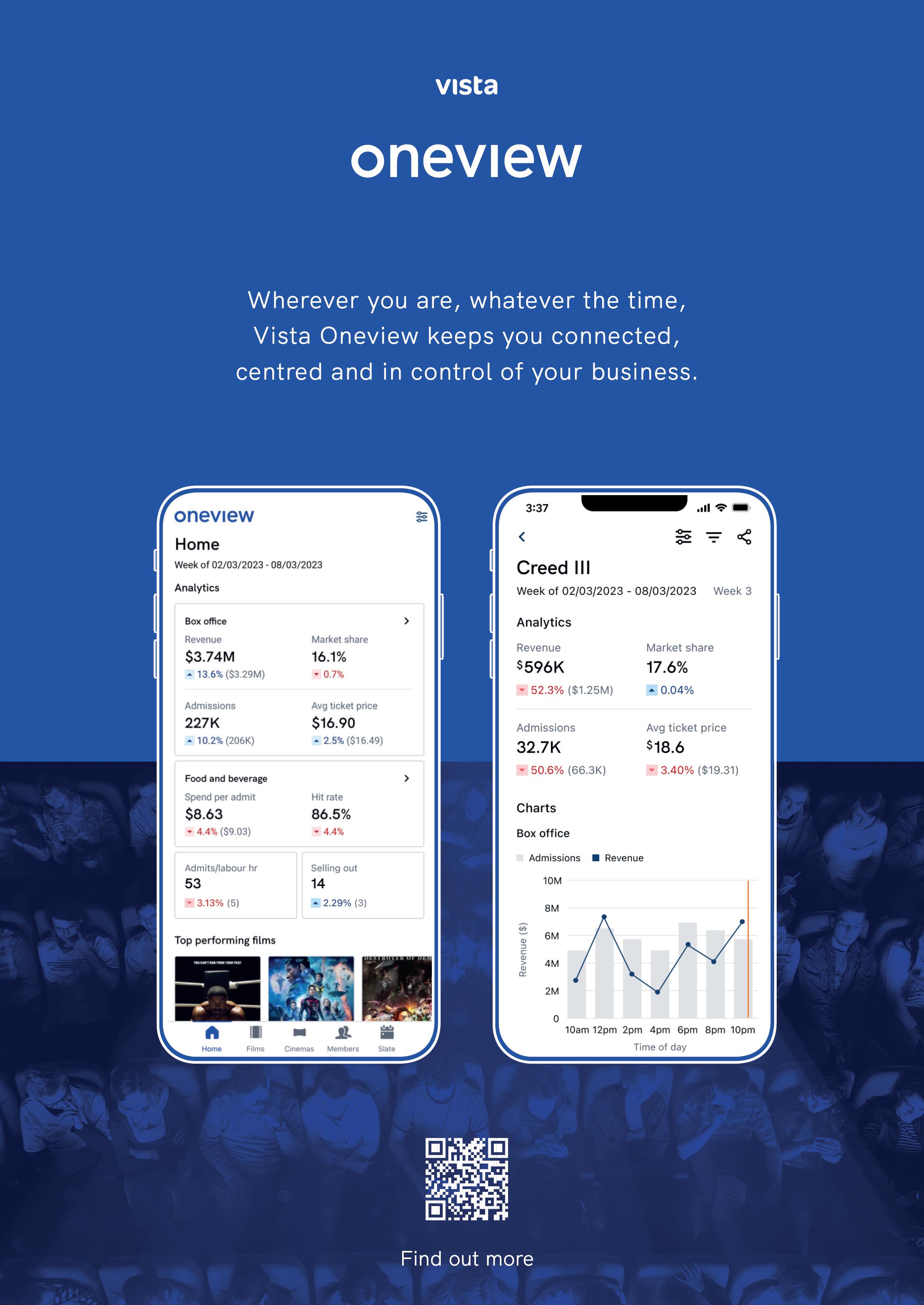
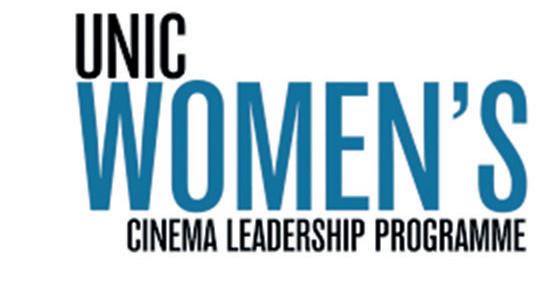
AT CineEurope, The International Union of Cinemas (UNIC), the European cinema trade grouping, launched the seventh edition of its Women’s Cinema Leadership Programme, a 12-month mentoring scheme for women in cinema exhibition.
Twelve talented female cinema professionals will get an exclusive opportunity to learn, enjoy networking opportunities and receive career advice from outstanding women executives from across the cinema landscape, each recognised for their leadership and business success.
The programme remains UNIC’s flagship initiative to help address the current gender imbalance at senior levels of the industry and works to encourage and empower female professionals as the industry looks to realise its full potential. The 2023/24 edition welcomes the following key female leaders and rising female professionals from the cinema exhibition landscape, representing 11 countries and 22 companies:
Tanya Easterman, Founder, Daiku, UK
Patricia Edeline, Chief Operating Officer and Booking Manager, Sociedad Cinematográfica
de Centros Comerciales, Spain
Christine Eloy, Managing Director, Europa Distribution, Belgium
Elisabetta Hoch, Regional Operations Manager, UCI Cinemas (OCG), Italy
Marilyn Iacovissi, Operational & Commercial Director, The Boxoffice Company, France
Marta Kowalska, Studio and Integrated
Marketing, Director Spain and Portugal, The Walt Disney Studios, Spain
Helen Moss,SVP International Distribution, Paramount Pictures International, USA
Renate Scheliga, General Manager, Maccs & Numero, Vista Group, Germany & Austria
Jenny Sidorova, Head of Marketing, DX, Norway
Alina Sigaro, VP EMEA Distribution, Universal Pictures International, UK
Delfine Van Boxlaer, Director of Talent and People, Cinionic, Belgium
Kristina Warner, VP Global Content Acquisition, D-BOX Technologies, Canada
Pia Ardovino, Media & Partnership Manager, The Space Cinema (Vue International), Italy
Sandra Bakula, International Marketing Manager, Cineplexx, Austria
Charline Baudry-Biancarelli, VP Global Marketing and Partnerships Strategy ICE Theaters, France
Melissa Delft, Senior Manager Business Intelligence, Cinionic, Belgium
Isabel Garcia, Commercial Director, ACEC Cines, Spain
Lauren Greene, Business Development Director, EMEA, Movio, UK
Elena Martinez, Senior Film Booker, Odeon Cinemas Group, UK
Maria Moro, Legal Head, Cine Yelmo, Spain
Hana Peoples, Film Industry Researcher, Alexander von Humboldt Foundation, Germany
Pilar Sierra Artieda, General Secretary, Gremi de Cinemes de Catalunya, Spain
Maria Sweeney, Group Chief Communications Officer, Showtime Group Solutions, Ireland
Zsófia Varga, Film Programmer, Everyman Group, UK
Welcoming this latest edition of the programme, UNIC CEO Laura Houlgatte commented: “Since its launch in 2017, the programme has created a community of more than 120 inspiring female professionals. It’s been immensely rewarding and humbling to witness their empowering journey – we are grateful to all of them for their passion, commitment and trust.”
THE DCP-2000, DCP-2K4, Doremi IMB, IMS1000, and IMS2000 media block certificates were designed to expire in November 2025. To continue using these servers, the certificates on the media block MUST be extended before the deadline on November 30, 2025. Failure to update the certificates before the expiration deadline will result in a permanent and unrecoverable media block state. Dolby has released installation packages to update the certificates expiry date to January 14, 2038. This procedure can be referred to as Certificate Extension.
In January 2023, Dolby released a Software and Security Manager for each server to support the certificate extension. The Certificate Extension packages, which extend the media block certificate, are serial number specific. Dolby has generated packages grouped in 1,000 serial number blocks to expedite the rollout. In addition, Dolby has made single serial number packages to reduce the file size.
Note: When run, the Certificate Extension package is designed to validate the certificate directory files on the system before and after the certificate extension. Over the years, Dolby customers may have modified or renamed some of the certificate files on the system, which will cause an installation failure with the Certificate Extension packages. The system will provide a warning saying: Verifying certificates are update… [Failure]. If you experience this issue, you will need to use the package “dcp2000_ims_ cleanup_cert-1.0.0.pkg” to clean up the certificate system files, then re-install the Certificate extension package. This package renames and re-orders the certificate files and does not change any other system function.
The Software and Security Manager updates do not change the relationship with a series 1 projector or Gore Interface board. If you were on current software before, updating to these new versions will have the same compatibility.
All the required files are available on ftp.cinema.dolby.com through the
“service” username and password. If you do not have access, please get in touch with your service provider to schedule these upgrades. Dolby highly encourages you to upgrade every affected server as soon as possible.
VPF purposes, you must not upgrade past 2.8.22. Since Dolphin 1.0 does not contain a Security Manager, a software upgrade is not required. Installing the certificate extension packages will be enough.
**Please note that software versions before 2.8.52 will not contain any warning about the expiry dates or a notification that the certificates have been extended
***It is critical that you not downgrade either the Software or Security Manager after extending the certificates.
GDC Technology Limited (‘GDC’), a leading global provider of digital cinema solutions, and DTS, Inc. a global leader in next-generation audio, imaging and sensing technology and a wholly owned subsidiary of Xperi Inc. (NYSE: XPER) announced a strategic partnership agreement at CineEurope to launch DTS Surround which will be offered to exhibitors worldwide exclusively through GDC.
After the server has been upgraded, the certificates can then be extended using the appropriate package. Certificate extension will change the end of the certificate validity to January 2038.
*For DCP2000 w/ Dolphin 1.0: If you intend to export the SMPTE audit logs for
In Software 2.8.52 and 2.6.52, Dolby added support to export the certificate information via SNMP OID dcpINVCertificateTable. Please note that if you are on any Software below 2.8.52 and 2.6.52, the OID will return with nothing as it is not supported.
DOLBY recently identified an issue that prevents the Security Manager from trusting the secure Real-Time Clock (RTC) past December 31, 2023. The RTC functions normally, but playback is not allowed when the current date is 2024 or later. In January 2023 Dolby released updated Security Manager versions to address this issue. To prevent missed shows, exhibitors should update before December 31, 2023. The update can still be performed if the deadline is missed to recover functionality. This issue can be referred to as the Y2K24 bug. The table below shows the servers Dolby believes are affected as well as the minimum versions that includes this fix. In addition to the Security Manager upgrade package, a Serial Number specific DLM is required to unlock the upgrade.
The required files are available on ftp. cinema.dolby.com through the “service” username and password. Dolby highly encourages you to upgrade every affected server as soon as possible removing any rushed updates near the deadline.
Note that according to Dolby, other
servers (DSS, IMS3000) do not have the 2024 issue.
Optimized X-curve targets and state-of-the-art room tuning practices deliver stunning sound quality with the DTS Surround solution.
Featuring Extended Frequency Range to improve the quality of presentation in surround sound theatre DTS Surround certified cinema features the core components of DTS:X installations and is easily upgradable to DTS:X for IAB.
Below you may find details of the upgrade process:
Using the QT Legacy User Interface: https://dolby.box.com/v/
CertExtension-LegacyUI
Using the Web User Interface: https:// dolby.box.com/v/
CertExtension-WebUI
Dolby also recommends using the same Security Manager to extend the media block certificate in advance of another critical deadline in 2025. Dolby highly encourages upgrading the software and extending the certificates at the same time you are addressing this issue.
“With audio technology playing an increasingly critical role in the moviegoing experience, we partnered with DTS to ensure we remain on the competitive vanguard. To enhance the shared experience, GDC first partnered with DTS to introduce DTS:X which replicates a realworld sound environment that transports the audience into a new dimension of sound immersion by delivering truly captivating entertainment experiences in the cinema,” said Dr. Man-Nang Chong, founder, chairman and CEO of GDC Technology Limited. “Now, the DTS Surround licensing program for cinema will offer theatre owners the opportunity to provide their audience the most compelling, surround sound experience possible.”
“At DTS, we rely on trusted partners to bring our technologies to life on billions of devices and in homes, automobiles, and cinemas. For the cinema industry, the GDC and DTS partnership is a powerful combination. GDC has been a trusted partner since we introduced DTS:X immersive audio in 2015,” said Loren Nielsen, vice president content & strategy for Xperi. “We worked closely together to launch DTS:X for IAB and now we are pleased GDC will bring an entirely new surround sound solution to the cinema industry for audiences to enjoy the filmmaker’s true intent.”
Galalite Screens, a leader in cinema screen technology, introduced their latest screen, the Mirage XDL 1.5.The Mirage XDL 1.5 generated an enthusiastic response at Big Cine Expo, captivating attendees with its impressive visuals. Yusuf Galabhaiwala, Director of Operations at Galalite Screens, stated, “We received requests from projector screen manufacturers for a slightly higher screen gain for larger screen sizes. In response, we introduced the Mirage XDL 1.5,
an RGB laser projector screen with a screen gain of 1.5. This marked the first opportunity for the Indian audience to experience the Mirage 1.5 at BigCine Expo.”
Furthermore, the Mirage XDL 1.5 exhibited superior contrast capabilities, enhancing image quality and delivering lifelike visuals that engaged the audience. Attendees at BigCine Expo were impressed by the enhanced black levels and exceptional clarity, allowing them to witness every scene
with detail and precision.
“We are overwhelmed with the number of bookings we have received for the Mirage XDL 1.5. Despite being newly launched, we have already received a significant number of orders. Additionally, we also received testimonials from our clients with a majority expressing their appreciation for Galalite’s exceptional quality and customer service,” said Siranush Whyte, General Manager at Galalite Screens.
premium film formats and cinema technologies, and EVT, owners of Event Cinemas, the largest movie exhibitor in Australia, announced that they have expanded their partnership to open the first ScreenX auditorium in Australia at Event Cinemas Robina on the Gold Coast, Queensland. Event Cinemas ScreenX will hold over 140 seats, including the choice to upgrade to a recliner, and with screens spanning 3 walls, it can display a picture up to 67.7 meters wide.
ScreenX is the world’s first multiprojection cinema with an immersive 270-degree field of view. By expanding specially selected sequences of a film onto the left and right-side wall of the auditorium, ScreenX surrounds audiences with exclusive story-enhancing imagery that naturally fills their peripheral vision and immerses them into
with filmmakers and studios to ensure the highest quality presentation of the film. To date, there are over 355 ScreenX auditoriums around the world in 38 countries.
“Our one-of-a-kind ScreenX is a welcomed expansion to our growing collaboration with EVT and Event Cinemas who are pioneers in the entertainment and leisure sector in Australia,” said Jong Ryul Kim, CEO of CJ 4DPLEX. “We look forward to more audiences experiencing movies in our premium format with a larger screen and deluxe seating.”
“We are thrilled to strengthen our partnership with EVT through Event Cinemas by premiering Australia’s first ScreenX theater,” said Don Savant, Chief Business Officer, CJ 4DPLEX. “Our talented team of ScreenX visual effects artists work closely with the Hollywood Studios and top talent to truly
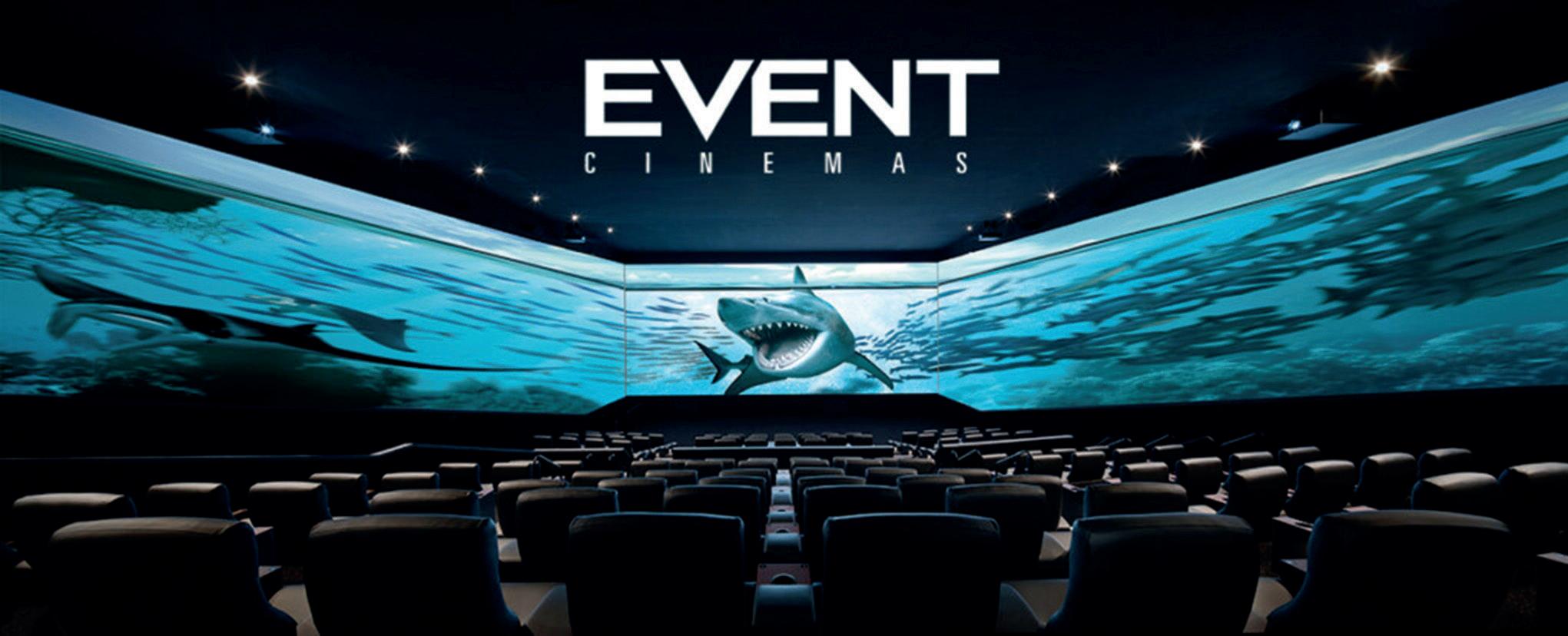
an unparalleled experience in a completely unique format to watch the biggest blockbuster films.”
“At Event Cinemas, we are dedicated to bringing world class cinema experiences to our consumers. We are excited to continue our partnership with CJ 4DPLEX and are proud to be the first to introduce ScreenX to the Australian market and further expand our cinema experience offering”, said Luke Mackey, Director of Entertainment for EVT.
CJ 4DPLEX and Event Cinemas’ partnership began in 2018 with the launch of CJ 4DPLEX’s multi-sensory 4DX theater at Event Cinemas George Street in Sydney, Australia. Event Cinemas now has four 4DX locations operating across Australia at Parramatta, Pacific Fair, and Chermside along with the inaugural George Street location.
THE renowned festival utilised the NEC NC3541L RB laser projector to create the ultimate cinema experience
In July, Sharp NEC Display Solutions Europe supported the fourth edition of the Festival Cinéma Paradiso taking place in the majestic Cour Carrée of the Louvre. By deploying an NEC NC3541L RB laser projector, Sharp/NEC provided state-of-theart cinema technology to create a mesmerizing cinema experience for festival visitors.
The Festival Cinéma Paradiso Louvre offered spectators four evenings of celebration – all about cinema in the Cour Carrée of the Louvre. Around 2,500 guests enjoyed a food court, entertainment, concerts and DJ sets as well as an open-air film screening in one of the most beautiful cinemas in the world. Co-organised by the cinematographic groupe mk2 and the Musée du Louvre, Cinéma Paradiso Louvre is part of the Les Étés du Louvre” festival with concerts under the Pyramid, theatre performances,

and dance in the Cour Lefuel.
Spectators at the film screenings were captivated by the performance of NEC NC3541L RB laser projectors, the first RB laser projector for premium and large format screens of up to 32 metres. The projector model offers full 4K resolution and wide colour space combined with a homogeneous and contrast-rich laser image quality, ensuring a very special experience for attendees.
“Cinéma Paradiso Louvre’s mission is to inspire wonder through the power of cinema, provoking amazement and enchantment at every screening. We assembled a team of experts and partnered with industry leaders to create the ultimate cinematic experience,” says Elisha Karmitz, CEO of mk2.
“We were happy to once again support the Festival Cinéma Paradiso Louvre with our technology and to offer visitors the best possible cinema experience,” comments Alain Chamaillard, Head of Cinema EMEA & CIS at Sharp NEC Display Solutions Europe. “Our laser projectors are the ideal solution to provide them with an amazing image quality.”
ON Sunday, August 27th, the second annual National Cinema Day in the USA delivered impressive results, attracting nearly 8.5 million attendees, up 5% from last year. The box office saw a 16% increase over the previous Sunday (August 20, 2023). According to Comscore, moviegoers aged 18-24 and 25-34 each made up 22% of the National Cinema Day audience, and the next largest age group was 13-17 with 16%. Women turned out in slightly higher numbers than men, making up 52% of the audience.
“National Cinema Day was a significant success in bringing together millions of film fans of all ages to enjoy movies on the big screen,” shared Bryan Braunlich, Executive Director of The Cinema Foundation. “Movie theaters and all our partners helped maximize the impact of the day
with creative marketing and special promotions that added to the overall excitement, while a diverse slate of exciting films provided something for everyone to see. Thank you to all those hardworking individuals who make the theatrical experience magical.”
In an increase from last year’s returns of over $24 million and more than 8.1 million moviegoers, the second annual National Cinema Day brought $34 million to the box office and 8.5 million attendees. More than 3,000 locations and more than 30,000 screens across the U.S. and Canada participated in National Cinema Day, and theaters reported sold-out showtimes in all formats throughout the day. All movies in all formats at all participating theaters were no more than $4 per ticket.
“The positive response to National Cinema Day is just another reminder of how much people love going to the movie theater,” said Michael O’Leary, President & CEO of the National Association of Theatre Owners. “In every corner, audiences came together in large numbers this weekend to share in the experience of seeing great stories on the big screen. These numbers show us that the future of exhibition is strong, and that consumer enthusiasm for the theatrical experience continues unabated.”
Building on the momentum of last year’s inaugural event, this year’s National Cinema Day was an all-industry effort taking place at a comprehensive range of theaters, from the largest theater chains to smaller independent venues.
The summer success of Barbie and Oppenheimer owe much to the joint marketing efforts of studios, exhibitors. But what did we learn? What did we get right? What can we improve for the future?
s I come back from a very remote part of the Brittany region in France, so remote that even in the month of August, my family and I barely saw any tourists, I was delighted to discover that the “Barbenheimer” trend was still very much alive and both films were still playing in several theaters around the town we live in, in the South West of France. I couldn’t help but keep my marketer’s hat on and smile as I was reminded of the power of brand, community marketing, original content, and so much more. For this edition, I’d like to dive into what these films have done so well, what they could have done even better, and what are some key marketing takeaways for us in the cinema industry to walk away with.
In an era marked by reboots, sequels and adaptations, the cinema industry has been thirsting for original content that captures the imagination of audiences and rekindles the magic of the silver screen. This summer’s releases have provided a breath of fresh air, showcasing the enduring power of captivating narratives. Barbie and Oppenheimer are prime examples of how original content can make a resounding impact. Yet, their remarkable success stories owe much to the meticulously crafted marketing strategies that accompanied them and the ricochet effect those strategies had on their communities, fans, and audiences. In other words, as often with marketing, we cannot attribute success to only one factor. Without the original content, there would not be the ricochet word of mouth effect. Without the existing power of the Barbie brand or the Christopher Nolan brand, there would be no community ownership before even the films’ release. And without the clever, original, and very well thought out marketing campaigns (and yes, paid advertising investment from the studios), there would not have been the massive organic engagement and content that was generated from both titles. So let’s remember, it takes an army and a 360 mindset approach to reach customers along every single touchpoint, and that’s exactly what both films did. As the box office figures continue to roll in, it’s clear that both Barbie and Oppenheimer have struck a chord with audiences. Barbie, in particular, has etched its name in history as the biggest domestic movie in the 100-year history of Warner Bros, a monumental achievement. (Source: Box Office Pro). And Oppenheimer, for its niche audience and sophisticated story line, not to mention 3 hour length, has also done triumphantly well, taking in $717 million, blasting far past its reported $100 million budget (Source: Forbes).
Technological advances, social media, remote working and gaming are fuelling a huge rise in the growth of the online community and the blurring between online and offline habits. As we are increasingly online, so too are consumers becoming creators - wanting to be active, vocal participants in a two-way relationship with a brand or product, not just passive viewers digesting advertising and marketing activity. To meet this new expectation, brands are looking at gamification tactics, building fan communities online, and working with influencers. Something that cinema is not exempt from. Immersive marketing doesn’t need to be big scale, or complex. It’s about thinking of ways your audience can become more involved in their cinema visit, or share their enjoyment of a film, so that they experience it on a bigger scale. The triumph of Barbie can also be attributed
Barbie’s marketing team demonstrated a keen understanding of the preconceived notions associated with the Barbie brand. Leveraging this existing imagery, they ingeniously created a new and original universe that embraced humour, fluidity, and consistency across all touchpoints.
This approach not only intrigued loyal Barbie fans but also enticed a broader audience into cinemas, not to mention a broader audience in terms of multigeneration. Rather than point out what all the existing press has pointed out in terms of success, I’d like to pause and look at a less common factor, but one that is worth paying attention to. Barbie had a strategic collaboration with other industries, and thus gave us a sentiment that Barbie took over the world, for a short time. One of my favorite marketing tactics is when industries allow for collaboration with unexpected, but relevant sources. Had Barbie just been a good movie, half of the adoptions we’ve seen would not have spoken to us. But a good movie paired with being a full on branding phenomenon, and we have a world of collaboration opportunities. A great example here is the monthly men’s magazine GQ, who took to the Barbie trend and created a series of short videos with Ryan Gosling around “Ken Things”. This is interesting to observe because we don’t actually know whether these videos were part of Hollywood’s budget to market this film, part of the magazine’s content and marketing budget, or perhaps a collaboration of both? What we do know is that the content performed extremely well (over 4 million
GQ Magazine’s “Ken Things” push resulted on well over 4 million views per posted video
The Box Office revenue for Oppenheimer at the time of writing
Barbie has become Warner Brother’s biggest ever domestic movie in their 100 year history
views per video) and boosted both the Barbie film, Ken brand, and overall awareness around this summer trend. Not to mention speaking to an audience that was not the prime audience (Barbie audience is 66% female - Source: TheWrap). Barbie represents a marketing phenomenon that both Hollywood, fans, and several industries leaned into. That type of marketing power is only possible with a strong brand.
In stark contrast and attracting a 70% male audience (Source: TheWrap), the marketing strategy for Oppenheimer took a different path, attuned to the nature of the film itself. Recognising that Christopher Nolan’s directorial vision and the cast would be pivotal to the movie’s reception, the marketing team crafted a campaign that not only delved into the film’s creation but also delved deeply into the back story and aspirations of the director. We saw Christopher Nolan almost as much as we saw the Oppenheimer poster and its actors, which is not always the case with directors. This is also partly due to Nolan’s strong presence as a brand himself. Many will go see Oppenheimer because it’s a Christopher Nolan film. Greta Gerwig attracted audiences as well, but paired with the strong Barbie brand, it’s difficult to distinguish between the trend and the director. With Oppenheimer, given the seriousness and more niche target in the audience, it’s more apparent. By crafting a marketing strategy that includes the director’s story and vision, a connection can be forged between the audience and the artistic minds driving the project.
to a marketing strategy that empowered the community. A Barbie movie-themed photo wall or booth invaded our Instagram feed weeks before the film’s release and everyone suddenly started wearing pink, all of their own will. TikTok challenges with content inspired by the film, and so much more.
The success stories of Barbie and Oppenheimer underscore the remarkable potential of community marketing and fandom engagement. Hollywood’s future marketing endeavors can significantly benefit from tapping into these resources to create resonant campaigns. The allure of community marketing lies in its ability to forge a deep and personal connection with audiences. When fans feel seen, heard, and appreciated, they become enthusiastic advocates, driving word-of-mouth promotion that often surpasses traditional marketing efforts. The success of Barbie in drawing in Generation Z is a testament to the power of connecting with specific audience segments through community engagement. By understanding the values, interests, and aspirations of this demographic, the film’s marketing team crafted a campaign that resonated deeply, sparking conversations and generating excitement.
As the cinema industry revels in the success of Barbie and Oppenheimer, it’s crucial to adopt a more holistic and long-term perspective. While celebrating these wins is well-deserved, industry stakeholders must remain vigilant about external
70%
factors that can impact the future of the industry. I can’t help but be surprised at how short-term focused all the conversation I’ve seen this summer to be. Yes, Barbenheimer has been a success. I refuse to say “cinema is back” because I don’t think it ever left. But as someone who cares deeply about the cinema industry and someone whose job also depends on it, I can’t help but be equally thinking about the impending writer’s strike and the dearth of exciting content in the coming months. If we’ve learned anything from Barbenheimer, let it be that original content and smart marketing paired with brand leads to success. So please, Hollywood, bring us some original content, and please, studios, bring us marketing campaigns that drive and embrace community engagement and community content creation.
Moreover, the potential for innovation in technology cannot be ignored. The intersection of cinema with technology, particularly the rise of NFT (Non-Fungible Token) loyalty programs, presents an intriguing opportunity for Hollywood to deepen fan engagement and monetization. Barbenheimer could have gone even further and generated even more revenue if these emerging technologies were included in the campaign through exclusive access to movie footage, raffle systems for memorabilia, partnerships with luxury fashion brands, or even launching an NFT marketplace. (Source: magic.link/posts/nftloyalty-barbenheimer) The point here is that emerging technology would allow the current cinema experience to go even further. Barbenheimer showed us what original content and marketing could do, but those remain traditional tactics. I’m excited for the shake up we’ll see in the movie-going experience as these new technologies play a deeper role in film development, distribution, and the movie-going experience.
BARBIE OPPENHIEMER 66% FEMALE MALEWhen The Super Mario Bros. Movie zoomed past $1.3 billion in the spring, there seemed little doubt that it would hold onto its pole position until the end of the year. This all changed in July with Barbie coming close to matching that worldwide gross in just five weeks. Film students will be analysing summer 2023 in years to come, with the counter-programming release of Oppenheimer offering the most perfect case study in audience segmentation and viral marketing.

Despite the focus on Barbenheimer, this summer has delivered a lot more than two crowd-pleasers, with three-quarters of ticket sales delivered by other films. Guardians of the Galaxy Vol. 3 was a whisker away from matching the series high of Vol. 2, Fast X is on a par with the previous two films, and Dead Reckoning is on track to be at least the third-biggest Mission: Impossible instalment of all time. Overall July box office was significantly ahead of pre-pandemic levels, running 17% higher than the 2017-2019 average for the month and pushing the global YTD total over $21 billion to date. The current pace is just 11% behind the average of record-breaking years 2017-2019. If momentum holds and the US actors’ strike doesn’t cause major movies like The Marvels, The Hunger Games: The Ballad Of Songbirds And Snakes or Wonka to shift into 2024, this year could hit $35 billion worldwide – getting ever closer to the prepandemic level of $42 billion. The Top 5 films released so far in 2023 have grossed over $4.8 billion between them, contributing a huge 22% of the year’s box office to date. The Top 5 films of summer 2022, led by Top Gun: Maverick, achieved an almostidentical worldwide gross by the same point in late August, but
without the benefit of a springtime blockbuster to match Mario. Comparing the reception of Barbie and Oppenheimer across the world, there are significant differences in their topperforming territories. While North America and UK & Ireland lead both tables, Mexico and Brazil have over-delivered for Barbie; France, Spain and India rank higher for Oppenheimer. Audiences rated both films as the best of the summer in our PostTrak UK exit poll, with Barbie scoring the highest ‘Excellent’ rating (71%) and Oppenheimer scoring the best ‘Total Positive’ rating (97% ‘Excellent’ or ‘Very Good’). Other top-rated summer releases with over 90% ‘Total Positive’ UK scores were Guardians Of The Galaxy Vol. 3, Gran Turismo, Are You There God? It’s Me: Margaret, Ruby Gillman: Teenage Kraken and Mission: Impossible – Dead Reckoning Part One. This illustrates the diverse slate on offer. Barbie was particularly effective at pulling in infrequent cinemagoers, with one-fifth of viewers saying they attend only once or twice a year – an impact matched only by The Little Mermaid this summer.

Building on Christopher Nolan’s long-standing relationship with IMAX, Oppenheimer ranks in the all-time Top 5 IMAX releases in no fewer than 54 territories, including 14 where it is the No.1 IMAX release and a further 19 where it ranks at No.2 (including UK & Ireland, behind only Star Wars: The Force Awakens). Oppenheimer released in China on 30th August, avoiding the date clash with Barbie and some successful local releases.
In the worldwide all-time chart, after five weeks on release, Barbie ranks at no.20 (between Frozen and Jurassic World: Fallen Kingdom), and Oppenheimer is at no.130 (between Captain America: The Winter Soldier and Gravity). Both will doubtless move up the chart before they’re done.
Focusing on cinemas across Europe, as in previous summers, the chart is dominated by Hollywood titles taking all but one of the Top 15 places. However seventeen of the Top 50 films in Europe this summer were European productions or coproductions, indicating a robust tranche of releases to complement the top tier of global blockbusters. Top local release in Europe is animation Miraculous: Ladybug & Cat Noir from France/USA/Japan, grossing €24 million and well ahead of its nearest competitor Jeanne du Barry. French films are consistently the strongest travellers to neighbouring countries, accounting for seven of the Top 10 films in Europe this summer. Germany, Spain and Ukraine are also represented, with comedy, family/animation and drama successfully crossing borders

As it stands, there is no sign of the cost-of-living crisis affecting cinema-going. The price of a ticket remains affordable
to the majority with exhibitors offering many special offers and discounts to help maintain the cinema-going habit. The huge volume of positive conversation around cinema is refreshing after a sustained period of pessimistic sentiment during and after the pandemic, and really changes the public’s perception of our industry. The late summer/autumn national Cinema Day events in many countries will further support this momentum, reinvigorating those who came back for Barbie and were reminded that a trip to the cinema is always The Best Day Ever.

nless you have been on an extended holiday recently, you will have noticed that cinema is back in the news for the right reasons. The “Barbenheimer” buzz has been a marketing masterclass in creating awareness, excitement, hype and ultimately translating this into cinema visits. The accompanying chart shows how cinema has actually fared each year (including to end July 2023) compared to the average performance registered between 2017-2019. All you can ask is that it is recovering each year and that the movement upwards is nearing the levels seen before the pandemic. Three countries are at nearly 90% so far in 2023, and China is at 94% of 2019 levels. Italy, which is recovering more slowly, is at 73% so far in 2023. Once the comparative revenue earned is at 90%, it is hard to argue that the market is not recovering. However, this article is not about the cinema recovery. It is relatively easy to assess the economic importance of cinema, both to the overall media sector and to a community, but the cultural importance of the cinema (the venue) is much harder to gauge, being a more qualitative assessment than quantitative.
I had an interesting discussion the other day about the cultural and social importance of cinema, which meandered its way to the question ‘what did you miss about cinemas when they were shut?’, which I did. The second thing I really missed during the pandemic was pubs and the reason is linked. In the same way as I could watch a film on my sofa, I could also drink a beer on it, but we all know this is not the same thing as going to the cinema or the pub. What is lacking is other people and ambience, and that is why cinema (and pubs) is still relevant. It wasn’t the movies I missed, I watched plenty of those, it was the cinema that was missing.
Cinemas are a vital part of the cultural fabric on many national levels: the films shown are a reflection of national culture or subcultures, they reflect the wider world to the audience, they frame moral and political discussions, they entertain and educate. As a venue a cinema is a social hub, a
part of architectural heritage, a place to meet, a place for discussion and increasingly a place to eat and drink. They are also an educator of people, from the little things (be respectful of others) to the bigger things (An Inconvenient Truth, Schindler’s List, etc). Increasingly, a wide range of events can be screened there (theatre, opera, debates, Q&As with Directors), all of which have a pedagogic use.
But is cinema a social experience? As the lights dim, we are exhorted to turn phones off, keep conversations for later and settle into a very ‘solitary’ experience. So, the cinema isn’t really a social experience. The social aspects come before and after but the immersion into a good film for two hours is a personal one, driving thoughts and emotions along until the end credits (and after with bonus clips). However, being with people also applies to theatre, pubs, restaurants, bars, comedy clubs, bowling and so on, so there must be something else that draws people to the cinema other than the social, and that is being with others and watching a film in shared company. Shared experiences have a number of positive influences on our emotional wellbeing and connectedness. There are several pieces of research showing that sharing an experience enhances its intrinsic value, even if the participants do not communicate about the experience itself.
Being the first to see a film is also a fundamental part of going to the cinema, that feeling of being part of something new. The notion that you are part of a shared local experience but also part of a global phenomenon is a powerful positive, enhanced by social and mass media. Connectedness is an intrinsic part of wider wellbeing, being part of the group. As the hype around a big movie begins to build, the cultural relevance of a movie also builds, bringing people together in a way that a restaurant, bowling alley or a bar can’t. The movie is the global attraction, but the cinema is the facilitator of that global power, acting as the meeting point for ideas, relevance, impact and experience. Other media cannot replicate the impact that a movie in a cinema can have. The cinema also frames an individual’s life, posting way markers along the course of our stay on this planet.
Cinema was never doomed and “Barbenheimer” and the power of marketing has created a buzz that has helped reinvigorate audiences in the cultural and social importance of the cinema and it’s showing at the box office.
The cinema acts as a socialiser for young children, helps to stretch attention spans and also educates with ideas, communicates valuable life messages and social expectations (cinema etiquette). As we grow older, the cinema is a vital step in becoming independent, a safe space for teenagers to socialise away from their parents, discuss with friends, share emotions and be entertained. For young adults, it is often a safe choice for a first date, with a guaranteed conversation afterwards. As we get older it is a night out with friends and partners, an escape from work, life, maybe boredom, a place to grab a bit of sleep, but also a place to share a family experience as children experience the magic for themselves. For older people, it is a safe place to get out to with a partner, but also maybe a place to get away from illness or solitude, keep the brain active and keep up with the world. Cinema is with people at every stage of the journey, and forms part of a person’s special memory bank.
Driving through a town and seeing an interesting cinema (even architecturally) marks that town out as different. A cinema can sum up, or enhance a town’s architectural fabric, giving pride to local people and sending a message to others about that town’s importance. The cinema also acts as a social hub, and a town without a cinema is one that lacks a vital part of life.
Another fundamental theme of cinemas is story telling. From getting a bedtime story as a child, we hear stories from an early age. This ability to pass on a wide range of stories is what marks humans out from other species (although life messages are
passed on in some other species). Added to the oral storytellers of old, came the carved stones, the written word, then the printed word, followed by live or recorded sound on the radio and finally onto the images (and subsequently paired with sound) that we see on cinema and television. The movie is an exciting way to pass on a vision of a story. Whilst the cinema is not exclusively the place for stories to be told, it is the one with the greatest impact and capacity for immersion in that story, provoking the greatest emotions and memories.
The cinema experience may be evolving into something different and less uniform as the sector undergoes stratification, but the core elements of the experience have to remain: shared experience and story telling. This is why VR in cinemas did not gain favour with audiences, there was no connection with others. Using a VR headset at home is one thing (and it’s fun) but we are used to being in small units or alone there; the constriction of the headset doesn’t sit well with the shared collective space of a cinema.
This summer we are all experiencing at the hands of a pink-loving doll and a hat-wearing scientist what cinema really is: a cultural phenomenon that has a potentially huge global impact on people (the individual) but also the community (the collective). The combination of two very different films has helped drive a summer box office bonanza for the cinema sector, but maybe more importantly, it has underlined to us all exactly why the hundred year (plus) old medium of cinema has a future. The absence of shared collective story telling that cinema represents is why I missed cinema and why we would all miss it if it wasn’t around.



Pearl & Dean’s famous ‘pah pah pah pah’ sonic ident is as instantly familiar to cinemagoers as the Intel Inside five note jingle is to people lost in talk about RAM and solid state drives, or – more recently – McDonald’s ‘I’m Lovin’ It’ tune when thinking about filling their tummy with fried food. Hearing that tune evokes the excited buzz of getting comfy in front of the big screen with a giant tub of popcorn, ready to enjoy the cinematic delight about to fill our senses.
Depending on your age, Pearl & Dean’s ‘Asteroid’ theme will either conjure up memories of cheaply-produced adverts for local timber merchants or nearby Indian restaurants with carpets on the walls (for some reason), or latterly, enjoying a movie at a screen of Showcase, The Light, or any of the 188 independently-run cinemas that work with Pearl & Dean today.
Our story starts in the 1930s, with the Pearl brothers – Ernie and Charles ‘Dickie’ Pearl, sons of Ukrainian immigrants – who worked as travelling salesmen in Cardiff. The Pearls sold such
things as town guides and other formats of advertisingincluding stills at the local cinemas and live theatres, where simple messages could also be projected onto the fire curtain.

Alongside Robert ‘Bob’ Dean, The Pearls rose to the position of directors of Rank Screen Services, who controlled the advertising in the Odeon and Gaumont cinemas. In 1953, the trio broke away from Rank Screen Services to form Pearl & Dean, obtaining the rights to advertise on ABC Cinema screens, which at the time was the major competitor to Odeon and Gaumont.
Up to that point, ABC cinemas had never shown adverts on screen, and so Pearl & Dean set about selling adverts for

leading brands such as Unilever and Beecham’s in front of such classic 1953 releases as Peter Pan, Gentlemen Prefer Blondes, From Here to Eternity and Shane.
Pearl & Dean pioneered many innovations in cinema advertising, introducing tailor-made commercials for local business and fast-moving consumer goods (FMCGs). These can still be seen today with Pearl & Dean reworking and remixing the legendary ‘Asteroid’ ident for brands. Also introduced were advertising packages – which set the industry standard that is still the norm in the present day.
Pearl & Dean was far from the first company to advertise in UK cinemas, that honour belongs, all the way back in 1899, to Dewars Whisky - which, delightfully, is still going strong in 2023. Cinema advertising really picked up speed during the WWII cinema boom, when people flooded to screens to see newsreels of soldiers’ progress in fighting in far off places. Central Office of Information (COI) propaganda pieces about ‘loose lips sinking ships’ and how the walls have ears were coupled with near-feature-length commercials from cigarette manufacturers and other leading brands of the day such as Ovaltine.
Pearl & Dean’s establishment coincided with another important entertainment launch in the ‘50s; that of ITV and its commercial television model. Always the pioneers, Pearl & Dean introduced 15 and 30-second adverts to cinemas which overtook those wartime reel-length commercials to become the favoured choice for advertisers.
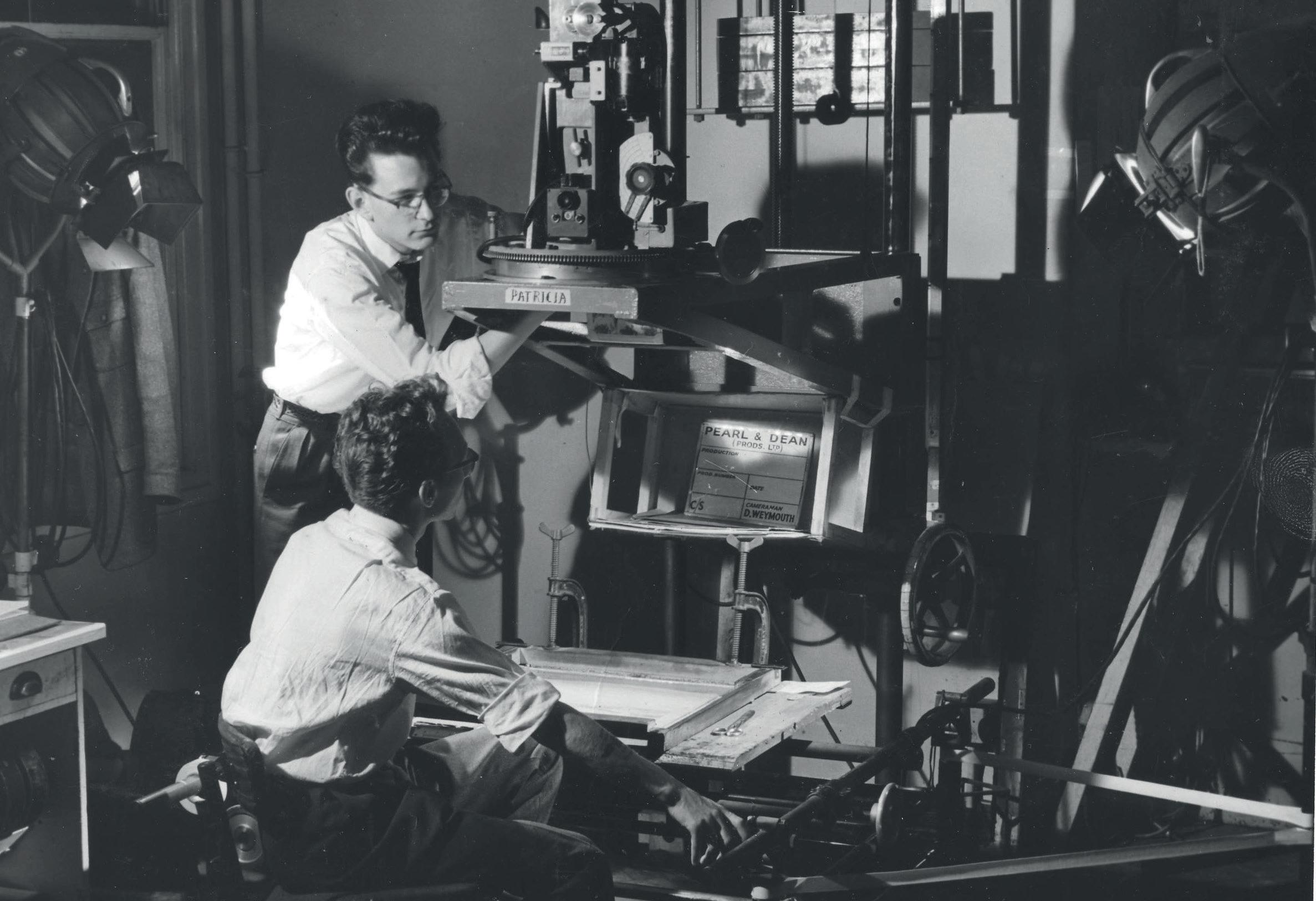
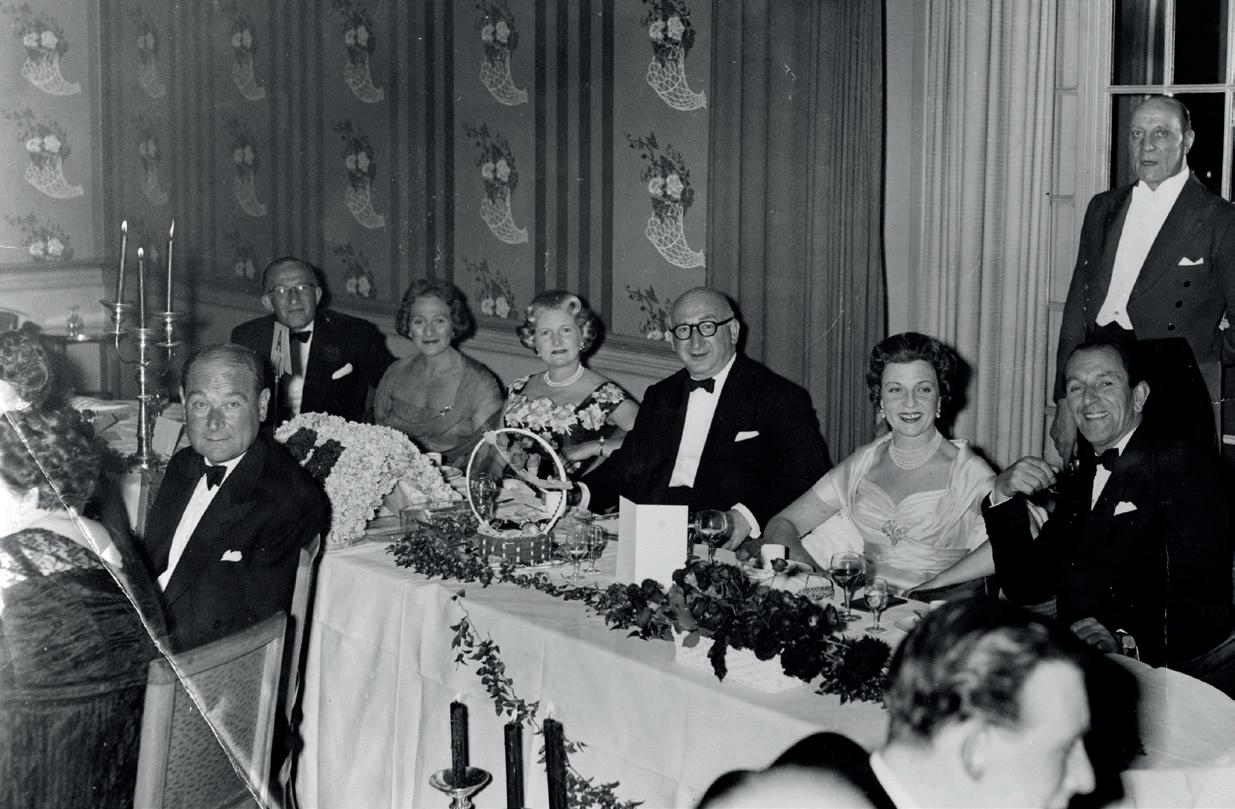
It is strange to think, but the iconic ‘Asteroid’ ident hasn’t always been part of the Pearl & Dean package. For the first few years of life, Pearl & Dean’s onscreen representation was that of the Pearl & Dean name in between impressive Grecian pillars, with some grand music. This was very ‘of its time’ – think of The Rank Organisation’s ‘Gongman’
When film producer and distributor British Lion Films purchased the company in 1969, it thought it was time for a refresh. Enter composer Pete Moore, who worked with the likes of Bing Crosby, Fred Astaire and Gene Kelly, as well as writing the themes for commercials for Coca-Cola and Lux Toilet Soap. In 1968, Moore stitched himself into the fabric of British cinema by composing Pearl & Dean’s iconic ‘Asteroid’ theme.
Moore’s 20-second ident went on to become one of the most instantly recognisable tunes in British cinemas and beyond and stood the test of time for the next 38 years. In the 2000s, with advertising adopting stereo sound, Pete Moore took his creation to the legendary Abbey Road studios, where
Rostrum camera c. 1955.he assembled a 30-piece orchestra to turn it into a two-minute tune. It is not only Pete Moore and his orchestra that have performed ‘Asteroid.’ Over the years, partnerships included the Guitar Hero video game’s rock band cover, while The Muppets Most Wanted movie had The Muppet’s Animal perform his own version before ‘smashing’ through the screen and providing a trademark drum solo. But the crowning ‘Asteroid’ achievement must be for the promotion of Queen biopic Bohemian Rhapsody, which saw the band’s Brian May and Roger Taylor provide their own inimitable take on the legendary ‘pah pah pah pahs.’
Despite Pete Moore’s ‘Asteroid’ song having been composed over half a century ago, thanks to frequent updates, the tune continues to feel nostalgic yet relevant. Film projectionists would set it as their ringtones, and it is often used as a shorthand for film – Alan Partridge, Graham Norton and Ant & Dec have all used the theme in their TV shows. Could you imagine the outcry if Pearl & Dean tried out a new song for
its pre-film ident? It’d be like MGM getting rid of the lion! By 1960, thanks to acquisitions and market manoeuvres, Pearl & Dean was the UK’s biggest cinema advertising company, boasting a 65% share of the cinema market.


Of course, without lows there would be no highs, as the 1970s brought a long-running series of declines for the owners of the beloved ‘pah pah pah pah’ tune. British Lion was unable to capitalise on the success that Pearl & Dean had forged. Dickie Pearl and Bob Dean retired from the company they created and British Lion was sold to poster and outdoor advertising contractor Mills & Allen.
Cinema was in decline in the late ‘60s and early ‘70s as television sets became more affordable and provided serious competition. Meanwhile, the world was in the midst of a recession, while bloated Hollywood studios grew unadventurous and formulaic with their output, unprepared
– or perhaps unwilling - to meet the expectations of a new, younger market. Pearl & Dean suffered just as hard as anyone in the movie business. Mills & Allen’s experience primarily came from the poster and outdoor advertising sector and it found little success in the highly specialised cinema advertising market, leading Pearl & Dean’s market share to plummet. With the market becoming a virtual monopoly between Pearl & Dean and Rank Screen Advertising (which The Pearls and Bob Dean originally left to form P&D), Rank gained an upper hand and then took over the ABC Cinema contract that Pearl & Dean had from its very beginning.
And while Hollywood rebounded with a new wave of young directors shaping ‘New Hollywood,’ with the introduction of the modern day blockbuster in the form of Jaws and Star Wars, Pearl & Dean didn’t see any such new wave.
Pearl & Dean’s market share had declined from 65% to 40%, and things became even grimmer for the company; by the turn of the ‘90s, Pearl & Dean’s market share had dropped to a meagre 12%. Enter a group of French media interests in 1993, who purchased the company for the nominal fee of 10 French Francs and relaunched the company under new management.
The relaunch lasted for six years, before it was sold again in 1999 to Scottish Media Group (now STV Group). In the intervening time, Pearl & Dean had recovered its market share to an impressive 44%, having recruited various cinema chains including Warner Village, National Amusements’ Showcase (now known as Showcase Cinemas), Cine-UK, Apollo, Caledonian and key independents.
STV decided to refocus its efforts on its core television business, and by 2010, had sold off all its non-television assets which included Pearl & Dean, which was sold – again for a nominal fee, this time £1 – to Image Ltd, a company backed by
Empire Cinemas director Thomas Anderson.
Meanwhile, Pearl & Dean’s long-time competitor Rank Screen Advertising was bought by Carlton Communications, which later came into the hands of Cineworld Group and Odeon Cinemas, who rebranded it as the current Digital Cinema Media (DCM).
For most cinemagoers, adverts on the big screen are part of the cinema experience; some ads are exclusively screened in cinemas, and even ones that are regularly seen on TV are much more enjoyable in a cinema auditorium with the big screen and the powerful speakers. There are a small few who are not so keen on the adverts but one thing is for certain, ads are very valuable to cinemas.
With ticket sales providing very slim profit margins, cinema exhibitors need to recoup the shortfall somewhere. The popcorn and drinks prices are one stream. But the income from onscreen advertising has often been an exhibitor’s makeor-break revenue stream. When big US multiplex operators first arrived on these shores, they’d felt that a ‘commercialsfree’ zone would be an attraction. But that attitude quickly softened when checking their balance sheets. Those who do have issues with the ads before films should bear in mind that these adverts are helping to keep cinemas operating and directly affording cinemas the opportunity to keep their ticket prices lower.
This brings us slap-bang into the here and now, with DCM and Pearl & Dean the two cinema advertising companies operating in the UK today. DCM, which has contracts with large multiplex chains such as Odeon and Cineworld, has a 79% share, and Pearl & Dean a 21% share of the market with Showcase, Empire, The Light, WTW-Scott, Omniplex and Moviehouse as their multiplex chains. Despite commanding only one-fifth of the cinema advertising market, Pearl & Dean is proud to be agile and provide bespoke advertising opportunities and packages to clients.
Having won the luxurious Everyman chain in 2019, Pearl & Dean has been able to build on the luxury approach to provide many tailored campaigns to the exhibitor. This attention to detail caught the eye of fellow high-end exhibitor Curzon, who moved to Pearl & Dean in summer 2023.

Pearl & Dean has built a special Luxe cinema network that includes the Showcase De Lux sites, Everyman and Curzon circuits, plus a host of lavish independent cinemas including the Berkhamsted Rex, Shrewsbury Old Market Hall and Savoy Heaton Moor plus a host of others across the nation. By bringing together these luxury 288 screens, Pearl & Dean can offer national scale to advertisers by working in partnership with their exhibitors.
Boasting 188 independently run cinemas across the
Pearl & Dean celebrates its 70th anniversary this month and for 18 of those years (and counting…) I have been privileged to be a part of its incredible team and its amazing journey. And what a journey it’s been and continues to be.
As a cinema advertising business, our mission is to champion cinema and film as a vital part of a brand’s communication strategy. And as a consumer-facing organisation, we also help to bring film and cultural moments into people’s lives. Everyone at Pearl & Dean has a passion for film and the cinema industry - otherwise we would not be giving our best each and every day.
This passion has driven Pearl & Dean to land some incredible brand partnerships and activations across multiple sectors. This year alone, we developed a fully immersive experience with Jaguar and Everyman Cinema to transport audiences to the hedonistic 1920s era of Babylon and worked with Gü to bring its indulgent desserts to our newly created Independent Collective for the blockbuster hit Barbie this summer. More recently, we have worked with Curzon to extend its current partnership with Kia to include sponsorship of Curzon Home Cinema – and we still have the rest of the year to go!
The Pearl & Dean team helps brands recognise the value and the endless creative opportunities this medium has, and they have a lot of fun in the process too. I am lucky to be working with such talented and passionate people. Ever since joining Pearl & Dean many moons ago, I’ve understood the importance of creating a workplace where people want to work and where everyone has a sense of belonging.
We’ve been adopting flexible working practices for 15 years and diversity and inclusion runs through our veins - 55% of our senior leadership team is female. I also make sure that decision-making is pushed downwards, so that all levels have a sense of responsibility and purpose. And I love being part of a business where the people you work with push you to excel.
I’m immensely proud of the strong workplace culture we’ve cultivated at Pearl & Dean - our retention figures are higher than average with half of staff having worked here for over five years. I firmly believe that having such a positive environment has contributed to our continued success as the UK’s best-known cinema advertising contractor, which in the last year has led us to win back impressive contracts with exhibitors such as Curzon and the BFI IMAX.
And while Pearl & Dean has a tremendous legacy, we are a forward looking company, focusing on innovation and ambitious creative opportunities. We have diversified our offering alongside the traditional ad-reel, to include experiential activations through our experiential arm DIVE, demonstrated by the building of engaging immersive outdoor experiences with the pop-up cinema brands that we are lucky to work with.
We are always buzzing with ideas and looking for new, cutting-edge ways brands can work with cinema exhibitors to tap into cultural moments, so that audiences of all ages can experience something truly relevant and memorable, and much like the Pearl & Dean brand itself, will stay in their memory for decades.
country, Pearl & Dean is the market leader in independent cinemas. Often a vital part of the community, business pressures made independents diversify, offering an alternative to a chain multiplex. They offer cafes, gallery spaces, restaurants and more to ingratiate into the local community, and are being supported by Pearl & Dean. This includes our recently launched ‘Indie Collective,’ which contains a collective of 30 independent cinemas from across the UK such as; the Reading Biscuit Factory, Woking Nova and Edinburgh Dominion, to provide them with the advertising revenues which allows them to keep on serving their communities the latest blockbusters and much-loved cult classics.
In 2023, Pearl & Dean’s ‘First For Film’ approach not only helped to regain the Curzon contract, but it also helped earn the contract to advertise with the BFI IMAX, which boasts the country’s biggest cinema screen – imagine the impact of an advert on a 512.8m² screen!

While ‘First For Film’ is the motto that Pearl & Dean lives by, it’s not just about on-screen. Pearl & Dean offers opportunities ranging from film partnerships, exhibitor partnerships, in-foyer advertising, sampling, ident takeovers and many, many more.
In recent years, moviegoing has broken out of the auditoriums into lavish outdoor sites. Pearl & Dean is proud to work with exhibitors such as The Luna Cinema, Adventure Cinema and Rooftop Film Club who offer the chance to witness much-loved movies, new releases and cult classics projected in such sumptuous locations as Kew Gardens, Chatsworth
House, Ascot Racecourse, or on the top of a former cricket bat factory in Peckham, offering unparalleled views of the capital.
There has been a concerted effort in the past half a decade for companies to think about sustainability and the environmental impact of their industries. Pearl & Dean is a member of the Advertising Association’s Front Foot initiative and the advertising industry’s Ad Net Zero – both initiatives designed to improve the media industry’s carbon footprint. As such, Pearl & Dean is committed to being carbon neutral by 2030, with a committed roadmap to Net Zero by 2050.
While doomsayers have been predicting the death of cinema as far long as cinemas have been around, the Coronavirus pandemic made a serious dent to the health and potential ongoing future of movie theatres. With cinemas closed indefinitely and streaming’s rise in the previous years, would cinemas ever reopen, and would people return if they did? When lockdowns were lifted, the restrictions meant that cinemas had to space out audiences, meaning that auditoriums were – at best – a quarter full. Things were looking bleak to say the least. But enter one man, one hero to save cinema: Tom Cruise. Cruise’s return as Pete ‘Maverick’ Mitchell in Top Gun: Maverick was the shot in the arm that cinemas needed, as audiences flooded back to see
Cruise take to the skies, grossing nearly $1.5 billion worldwide, and £83 million in the UK – a total that would see it close to the top of the UK’s highest-grossing films of the past decade.
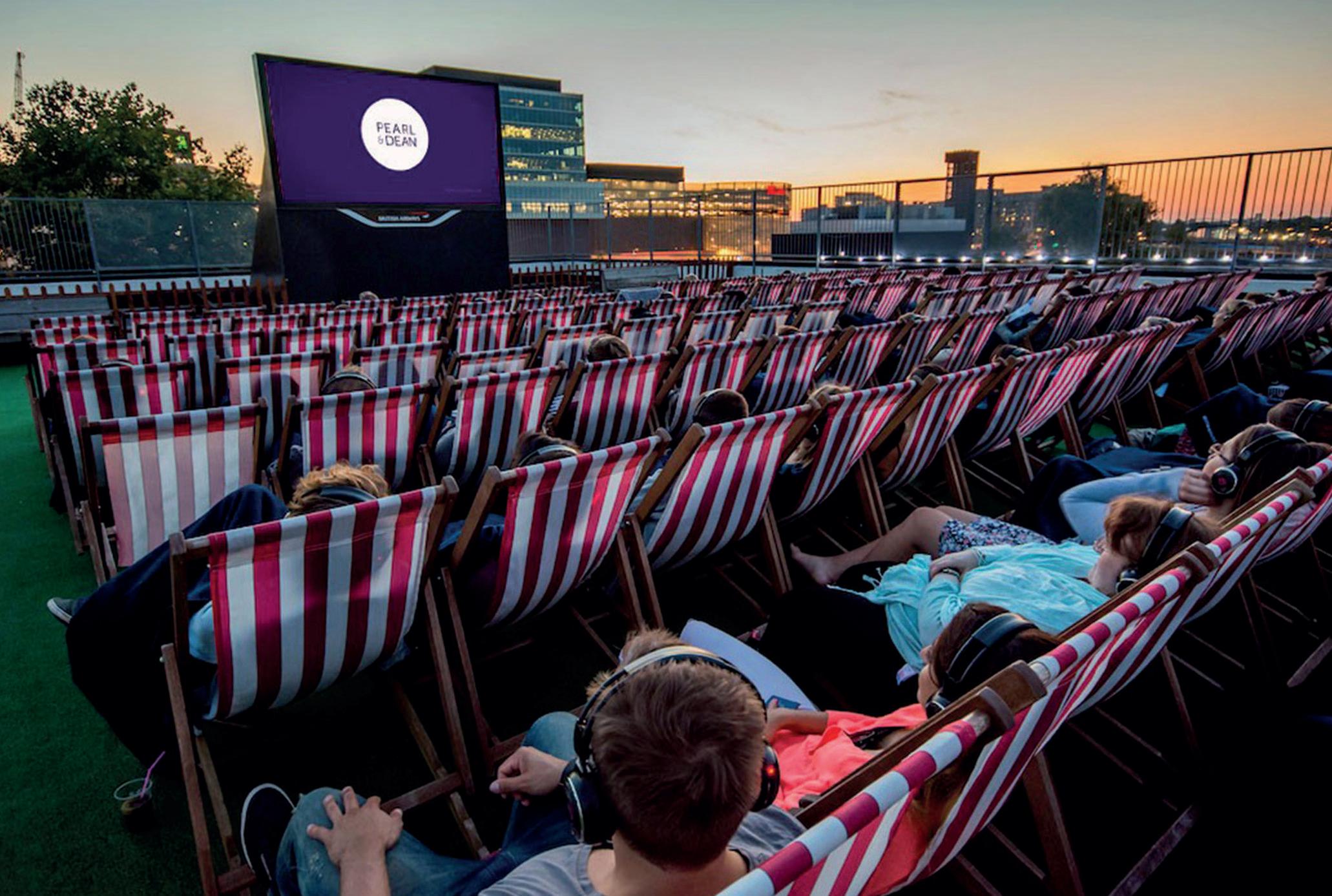
Moreover, the recent ‘Barbenheimer’ success, which saw same day releases for Greta Gerwig’s Barbie and Christopher Nolan’s Oppenheimer amass 7.3 million admissions in their opening week – the second highest number of admissions in UK on record – proves that cinema is here and just as healthy as ever. The current media landscape, with streaming services and our phone screens vying for attention, is very different from those in which Ernie, Dickie and Bob forged a successful company selling advertising. Even modern cinemas are dramatically different from those in which Pearl & Dean began. Boutique indies and high-end chains such as Everyman and Curzon offer happy hour deals and have a full kitchen, allowing cinemagoers to order pizza directly to their cinema seats, while people are watching films in sunlit parks and rooftops up and down the country.
However, one thing that hasn’t changed since Pearl & Dean started selling onscreen adverts 70 years ago, is that audiences – across generations - return, time and time again. And they are still being captivated by the creative and powerful stories told on-screen, from engaging advertising to the latest cinematic delight.


Laser projection both Phosphor and RGB afford exhibitors with a number of benefits including lower power requirements, the removal of consumables (lamps) as well as new and brighter images with higher contrast. But as exhibitors transition their projection estates from xenon to laser, the screen still remains an important consideration becuase of various potential benefits.
The pathway to transitioning from xenon-based projectors to laser is significantly more complicated than the transition from film to digital due to the lack of a VPF scheme. Against the backdrop of the pandemic, many exhibitors are rightly cautious about large capital investments due to the significant depletion of cash reserves. But the transition to laser will become more of a necessity as equipment ages and parts become in short supply.
When making the transition, the choice of screen can help to optimize the projection solution often lowering the output requirements of the projector.
Let’s consider the example of an exhibitor with a 15m wide screen looking to transition from xenon to laser. In order to meet the DCI specification for centre-screen brightness (14fL +/- 3fL) whilst allowing for sufficient power headroom in the projector, a unity gain screen (a 1.0 gain surface) would require a projector with a maximum lumen output of 40,000 to be used.
A screen even with a small uplift in
gain (reflectivity) would afford the exhibitor with the opportunity to reduce the light output requirements significantly opening up the ability to procure a lower lumen output projector. With a 1.4 gain screen, the light output requirement for a 15m screen would drop by around 13,000 lumens which could create a capital cost saving in excess of €40,000 on the price of a new projector. Similarly, the logic is transferrable to a smaller screen. A 7m wide screen with a small gain uplift could yield a saving of around €7,000. Imagine the impact of spreading this theory over multiple screens or across a larger estate, the effect could be profound.
In a world where capital budgets remain stretched but the urgency to replace ageing xenon-based projectors is increasing, such a methodology might help to stretch capital budgets allowing for a faster roll out of projection technology, and of course switching from xenon to laser technology has the immediate impact of saving on operational and power costs.
€40,000
€7,000
There are obviously enormous operational costs associated with running xenon-based projectors.
As well as ongoing lamp costs, relatively large power requirements and also the ever-increasing cost of labour and transport associated with regular lamp changes, with laser, much of the operational cost is removed, in fact it’s a huge benefit to making the light source transition. However, optimising power
requirements and associated costs for laser should still be a consideration. Optimising the screen choice can reduce brightness requirements which in turn can create the opportunity to purchase a smaller projector which in turn can have the secondary effect of potentially lowering energy consumption. Looking at the larger (15.00m x 8.11m) screen example and an assumed energy price of €0.29/kWh, we can identify the potential power savings.
Let’s once again take our smaller screen example (7.00m x 3.78m) for a similar calculation.
EXAMPLES BASED ON THE
OF 3,500
Using this example, a cost saving of €215 per annum can be realised due to the optimisation of the projector and screen. If we assume the life of the screen is ten years, the return on investment could be as much as €2,150 in power and over €9,000 in total (projection cost and energy usage).
PER ANNUM.
Equipment manufacturers are conservatively forecasting that over the life of the projector it may lose up to 50% of its light output although this is still somewhat of a grey area given the relative newness of laser projection and sufficient real-world data.
So, to ensure the projector maintains sufficient brightness throughout its planned lifetime, manufacturers are often recommending starting projector power at no greater than 50% of the maximum power/light output and then
increasing the power level over time as light output diminishes.
This of course is a significant factor in selecting the appropriate projector and again the screen can assist in this in exactly the same way as demonstrated previously where we identified how a screen can help create an affordable solution. Let’s look at the two screen examples again and using the higher brightness projector options for both to showcase the impact of screen choice on starting power levels.
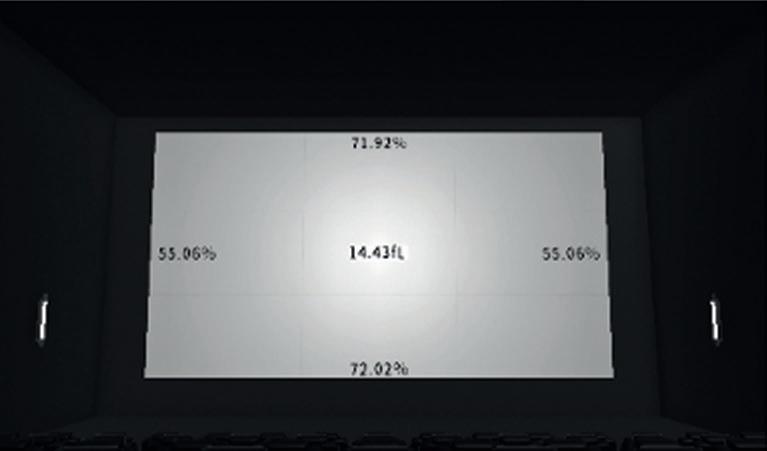
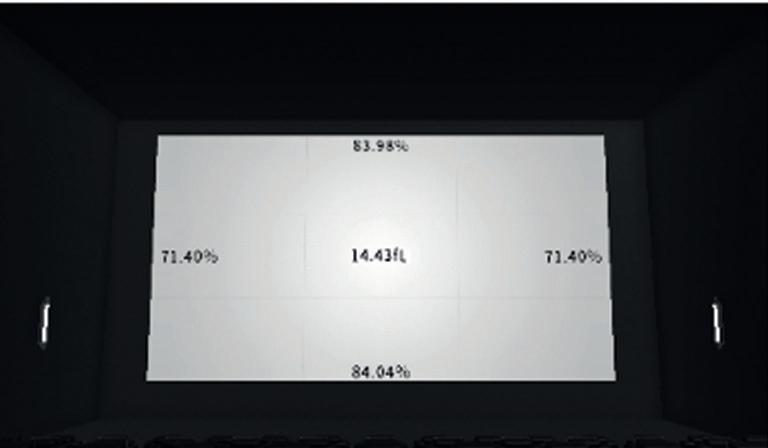

Replacing a screen with a higher gain screen will impact the centre-to-edge (and potentially top-to-bottom) brightness uniformity of the onscreen image. This in essence means the creation of, or increased visibility of, a hot-spot on screen. Whilst screen manufacturers have over the past ten years significantly evolved their products to create gain screens with wider viewing angles, uniformity should still be a major consideration in any screen change because large uplifts in gain can negatively impact the viewing experience of seats at the periphery of the auditorium.
Let’s look at the impact of screen gain on uniformity by contrasting a variety of screen gains as viewed from the DCI position (centre of the seating area).
In both instances, the increase in screen gain assists in lowering starting power requirements close to or below manufacturer recommendations.
are
benefits for considering screen selection as part of projection refurbishment project, however there are of course a number of factors that need to be considered before selecting a screen.
There
tangible1.0 GAIN 1.4 GAIN 1.8 GAIN IMAGES COURTESY OF HARKNESS SCREENS.
Looking across the three screen examples above (utilising the 15m example), centre-to-edge uniformity drops by 44% overall although far less dramatically by increasing gain by one increment. The impact of uniformity changes is of course governed by a number of factors including auditorium geometry and of course screen width.
Of course, the uniformity issue can indeed work in reverse, particularly when considering the switch from xenon-based projection to laser where 3D is a consideration. The higher brightness capabilities of laser projectors can in some instances allow for traditional high-gain silver screens to be replaced with current generation premium 3D screens which benefit from lower gain and wider viewing angles thus improving presentation quality. Where a traditional silver screen would have a visible hot-spot in the middle of the screen, current generation screens distribute light more evenly across the surface reducing hotspotting dramatically making for a more uniform image.
One of the key considerations with gain screens and indeed laser projection is the visibility of speckle on the screen. Typically associated with RGB projectors, speckle is an interference pattern that can disrupt the viewing experience of movie-goers. Although speckle is visually subjective and the level of interference can differ from person to person depending on their eyes, there are factors which can potentially increase the visibility of speckle on screen such as viewing distance and brightness.
Whilst it is important to note that screens do not create speckle, their optical properties can increase the visibility of it. Screens with gain (particularly those over 1.8 – both white and silver), by being more reflective, can increase the visibility of speckle. If for example an exhibitor is transitioning from xenonbased projection to RGB laser and the screen is a first-generation silver screen with a high-gain (over 2.0), it is likely to amplify speckle more than using a lower-gain light diffusing current generation premium 3D screen. There are of course solutions that allow for the mitigation of laser speckle using high gain screens such as “shakers” applied to the back of the screen to vibrate the surface and disrupt the wavelengths of light hitting the screen but these are often expensive, add to the power requirements of the auditorium and are difficult to retroactively fit to a screen. Projector and screen manufacturers can offer guidance on laser speckle reduction and mitigation and this advice should always be sought ahead of a new RGB laser installation.
Moiré is another interference pattern which can cause disturbance to the viewing experience.
Moiré is caused when the “weave pattern” of a screen (the perforations) aligns and then interferes with the projector’s pixels resulting in an undesired, strobe-like effect across the screen. There are a number of factors which affect the appearance of moiré including auditorium geometry, the projector lens but potentially most significantly the resolution of the projector due to the size of the pixel as it meets the screen. With a move towards 4K with laser, the potential for visible moiré may be increased. There are temporary solutions which can be used on site in an attempt to rectify this however screen manufacturers can advise on perforation pattern prior to install – something that is worthwhile investigating.
Let’s consider the 15m screen with the two screen types, a unity gain 1.0 and a low-gain 1.4 screen. Given the two different projector options, a saving of over €40,000 in the purchase price may be achievable.
What about the cost of installing a new screen?
*MAY BE SIGNIFICANTLY LESS IF CHOOSING BETWEEN
One-Off Savings:
Let’s not forget that potentially the cost saving isn’t oneoff but a long term one when considering power consumption requirements. Screens typically have a lifespan of seven to ten years so we can look at how the screen might save even more money over the lifetime of the projector.
Taken as a complete package, an optimized laser projection and screen system could yield substantial savings (in the case of the above, in excess of €45,000!).
The screen can play an important part in managing or reducing capital and operational expenditure for what is one of the largest costs associated with running a cinema in projection, whilst at the same time improving the viewing experience for movie-goers.
Return on investments can be profound and, in some cases, instantaneously realised. However, careful planning and guidance should be sought by screen manufacturers and integrators/installers prior to finalizing purchasing decisions to ensure that
the decisions made meet the specific requirements of the cinema and do not overtly compromise the viewing experience.
Depending on the age and condition of the screen along with its gain characteristics, in most cases the screen should be a replacement consideration when installing a new projector, particularly laser-based technology and especially RGB projectors to ensure presentation excellence.


With the rollout of DTS:X for IAB (Immersive Audio Bitstream), the IAB-compliant DCP’s will be labelled “IAB” in the CPL. Since this can be confusing, it’s time to clear up any confusion. Are you ready? Here are the five most common questions you’ve always wanted to know (but didn’t know whom to ask).
1
Is it true that only Atmos auditoriums can play Atmos DCPs?
No. The SMPTE ST 2098-2 established an immersive audio bitstream (IAB) standard that allows IAB-enabled auditoriums the capability to play DCPs that may use the IAB or Atmos naming convention.
2
Can you play DTS:X DCPs in an Atmos auditorium?






No. Only auditoriums with DTS:X rendering license and KDM can play DTS:X DCPs. As the motion picture industry transitions to IAB DCPs, some studios will continue to release DTS:X DCPs until they completely transition to IAB DCPs.
3
Can an auditorium play an IAB DCP without DTS:X, Atmos, or AuroMax processor?
No. The IAB DCP contains the immersive audio delivery file. The IAB DCP requires an immersive audio KDM and IABcapable processor to properly render and direct the audio to its designated sound placement in the auditorium.
4
Can I advertise my auditorium as Atmos or AuroMax compatible if I install DTS:X for IAB?
No. Each IAB-capable processor has its own licensing agreements and proprietary technologies. IAB is the interoperable immersive audio format on which the industry has agreed and standardized. While all IAB capable processors can play the same IAB DCPs, only the auditorium featuring DTS:X licensed technology can only be promoted as DTS:X, regardless of the types of DCPs being played.
5
Aren’t all immersive audio rendering solutions the same?


No. Each format offers unique features, rendering algorithms, and optimization approaches, it is essential to consider the specific attributes and capabilities of each rendering solution when selecting an immersive audio system.
DTS:X for IAB offers a flexible design configuration that optimizes the immersive audio performance of each auditorium. DTS:X for IAB is completely interoperable with DCPs labelled either IAB, Atmos, or DTS:X.

laser is one of our most meaningful achievements. We do not take it lightly and our commitment to the future of theatrical presentation has never been stronger as we continue to develop new ways to support our customers. Cinionic’s green initiatives are enabling a more environmentally friendly and economical industry; while our growing service and Cinionic Academy programs support longevity for technology resources and exhibitor field teams.
CT: Do you think that Barco and Cinionic have succeeded with the aims of creating the company?
CT: What have been some of the highlights from the previous five years?
Cinionic has achieved remarkable milestones over the past five years, positioning us as the leader in cinema technology. Most notable is the rapid adoption of Laser Projection by Cinionic, now with a footprint of over 35,000 screens worldwide.
Thanks to our laser-driven technological and commercial innovations, we have expanded partnerships with many of the major global exhibitors, including AMC, Cinemark, Kinepolis, Cinepolis, Cineplex Canada, Muvi, TOHO Cinemas and PVR, among many others.
The pandemic presented many challenges for our industry, but Cinionic was able to successfully navigate it while keeping our team together and supporting our customers. We have continued to prioritize the needs of exhibition. That focus led to our bold move to an all-laser product portfolio in 2021 and the introduction of new ways to think about cinema technology with Cinema as-a-Service and Laser Light Upgrades.
CT: And of those, what do you think has been the biggest achievement for Cinionic?
Cinionic is reshaping the way we think about cinema technology today. We have built upon our Barco heritage with the leading laser portfolio, moving from technology provider to cinema companion. The trust our customers have put in Cinionic to power the next era of moviegoing as shown by the rapid move to
Cinionic came together to serve as a dedicated cinema venture, focusing on supporting and enabling exhibition through financial flexibility, laser projection, and delivering ‘wow’ experiences for audiences. With our singular focus and longstanding industry relationships, we are succeeding in our mission - but there is always more to be done. We are constantly looking for ways to improve the guest experience and drive efficiency for the exhibitor across the theatrical value chain. There are still many screens we can support and enhance, serving as their cinema companion. In the months and years ahead, we aim to continue on this mission toward 100% laser conversion and the long-term sustainable elevation of cinema.
CT: What do you think are the biggest challenges for Cinionic and for the wider cinema exhibition industry as a whole?
Cinemas today have a range of challenges to contend with, among them are changing audience expectations, fluctuations in the release schedule, and rising operational costs. For Cinionic, our focus is on how best to support our customers, and the industry as a whole, in addressing these. A strong pipeline of new content is vital for attracting moviegoers. Our responsibility is to work closely with exhibition to ensure that their technology infrastructure offers the maximum flexibility for content programming and increased operational efficiency overall.
CT: At CineEurope this year, you had a demo of Augmented Reality (AR) for training and working on projectors - would you be able to talk more about this and how this sort of technology (including AI) is being looked at within Cinionic?
At Cinionic we continue exploring and investigating new technologies and services that can enhance the operations of
our customers and ourselves. We do not do innovation in isolation. We work with the industry to find solutions through co-creation, listening to the market and testing to find what is meaningful and to uncover new ways to use technology in the cinema space. Technology-assisted service within a cinema environment is really interesting and we are currently testing it in different applications, in advance of any commercial offering to the market.
CT: Sustainability in cinema is obviously important, we have previously run an entire article about how sustainability is in the DNA of Cinionic and Barco. Are there any updates on initiatives around this since we last spoke back at the beginning of the year?

Sustainability is built into our business model, and we are constantly looking for ways to improve and do better. This year, we reached our corporate 2023 goals for sustainability (vs baseline 2015) and continue to strive toward reducing our carbon footprint by 2025. One example is the realization of a new wind turbine at our HQ in Kortrijk, Belgium.
We are now in the process of setting our targets for 2030, as the next intermediate step toward net zero in 2050. An important aspect is improving our reporting in accordance with CSRD, which takes effect in January 2024. This has a dual impact – on our corporate reporting and the associated required actions, but also in assisting our customers in their own reporting. A majority of the global cinema chains will have to comply with this CSRD reporting directive and as a major supplier, our products and services have a significant impact on their cinema operations. We provide tools and knowledge to our customers with regards to material usage and power consumption, as well as best practices on how to optimize the use of equipment during and after
operations. This includes assisting in EOL/EOS challenges of equipment. We are also advancing our Cinema-as-a-Service solution, which is a circular economy initiative where material resources get optimized whilst unburdening exhibitors from certain responsibilities inherent in ownership. In this model, Cinionic ensures optimized use according to design parameters before, during, and after operation.
In the next five years, there are certain to be advances in technologies and evolutions in consumer behavior. Our priority during this time, as always, is to provide solutions that enable our customers to meet new challenges, expectations, and opportunities with confidence. That may come from new technical advancements that continue our mission to deliver the ‘wow’ factor for audiences; new business models that facilitate growth; or through ever-smarter operations that harness data to uncover new insights and services for a next-generation theatrical environment. While the specific priorities are more likely to change the further out we look, we are steadfast in our commitment to supporting our customers and continually advancing the theatrical industry.
We are at a pivotal time for our industry; the actions we take today will drive what the future of cinema will be. It is imperative that everyone – from exhibitors to vendors to studios – look at what initiatives need to be taken now to ensure a robust and sustainable industry for years to come. Technology is always evolving and Cinionic is committed to partnering with the industry to enable a bright, sustainable future for cinema.
In the past decade, there has been much discussion in the movie theatre industry about using LED screens, much of which has been included in the pages of Cinema Technology Magazine. Despite their widespread use in various settings, especially retail, LED screens within cinema auditoriums has been limited. The number of Cinema LED Screens that have been installed has been slowly growing, with GDC announcing in December 2022 that they had sold more than 100 of their LED control units. The screen count of LED screens is however in the hundreds rather than the thousands or even hundreds of thousands that represent traditional projection-based systems. However, in 2023, several companies introduced groundbreaking innovations in this cutting-edge display technology. One of these companies is LG, a well-known and established international electronics company primarily in the consumer sector but still regarded as a new entrant to the cinema industry.
At CineEurope 2023, attendees were able to witness for
themselves the LG Miraclass LED screen being showcased in a traditional cinema auditorium at the Odeón Multicines in the town of Vilanova i la Geltr a short distance from Barcelona.
LG announced their LED Cinema Screen, known as the LG Miraclass, back in February 2023. The name ‘Miraclass’, a combination of the words miracle and class, means incredible image quality that can enhance audiences’ sense of immersion.

The LG Miraclass currently consists of four product lineups offering different sizes of screens (from 14 to 101 square metres) and screen resolutions (4K/2K) to choose from. At five metres wide, models LDAA025-1 and LDAA012 are designed for smaller auditoriums. All Miraclass displays provide compatibility with Dolby’s Integrated Media Server, IMS3000.
Employing self-emissive LED pixels, each LG Miraclass model delivers 24-bit colour processing with the capability of displaying 68.7 billion colour variations and outstanding contrast (4000:1) to give on-screen images depth and vibrancy. LG also boasts that they provide strong, consistent brightness
LG Electronics, a renowned South Korean multinational electronics giant, traces its roots back to 1958 when it was established as GoldStar. With a rich history, LG has emerged as a trusted household brand, captivating consumers with its cutting-edge electronic devices, including state-of-the-art television technology.
Recently, LG committed resources to developing a next-generation LED screen, aiming to revolutionise the cinematic experience.
Described by LG as being meticulously designed for unrivalled visual quality, with this innovative LED screen, LG is promising to enhance the immersive nature of movie-watching to unprecedented levels.
with no corner dimming and produce clear, distortion-free pictures. The screen brightness of the LG Miraclass can be adjusted across five stages, from 48 to 300 nits, offering suitability for various use scenarios – from playing 2D/3D movies to delivering content for company presentations or special ceremonies. The LED screen can also handle a variety of different frame rates (24, 25, 30, 48, 50, 60, 144 @ 3D).
Despite the relative newness of LED movie screens, LG’s LED-based displays can already be found in several major theatre chains around the world, with more installations on the way throughout Asia, Europe, and North America. In Spain, an LG Miraclass screen has been installed in the Odeón Multicines theatre in Vilanova (see below), with more displays arriving soon in Odeon Multicines theatres in the cities of Madrid and Barcelona. Some of these cinemas will transition to 100% LED screens in all their auditoriums.
Odeon Multicines Vilanova, in collaboration with LG, introduced Catalonia’s first LED cinema, at the ODEON STAR room, alongside Christie Vive Audio speakers and Dolby Atmos sound as part of a recent refurbishment. The LG LED Screen was installed within one of the smaller auditoriums of this multiplex. The screen installed is 5.1 x 2.7 metres with 2K resolution, and this screen is made up of 8 million individual pixels that are capable of producing light levels from 48 to 300 nits in brightness, uniformly across the screen. The screen is DCI P3 certified and has a published lifetime of 100,000 hours. The screen in the auditorium is
able to show content in both 2D and 3D at the push of a button. LED screens are made up of several panels to make a single cabinet, and this one has 48 (six rows of eight panels) that are suspended from the ceiling of the auditorium. Like many other branded technology experiences, the LG screen has its own bespoke entranceway to make sure that the audience knows exactly who is providing the technology. The LED screen has completely replaced the traditional Auditorium cinema screen. The 5.1-metre screen consumes between 3.9 kW and 9.7 kW of power, depending on the brightness, although there is no additional heat extraction added to remove the heat from the auditorium.
As you would expect from an LED screen with such a high pixel ratio per panel, the picture quality was incredibly sharp and clear. In fact, you had to be seated in the front row to actually see the individual pixels begin to appear on the screen. The trailers being demonstrated were obviously chosen to show off the variety of different scenes. The 3D was some of the best that I’ve ever seen, although others present in the auditorium felt that the 3D was too bright and probably needed a more appropriate grade for the light output.
The room had been fitted with Dolby Atmos, using Christie Vive audio speakers (each speaker was highlighted with LED lighting). The front screen speakers were therefore in front of the LED screen in the ceiling. Overall, the sound was clear and
audible, but personally, I felt that the auditorium was missing some of the kick from the bass frequencies that I’d prefer.
During the pandemic, I got to experience hands-on LED Screen technology, making use of it to screen movies in outdoor environments. As a result, I experienced some of the many benefits and disadvantages of the technology, especially when compared to the more traditional projection technology. I was therefore really interested to be able to experience a true Cinema based LED screen for the first time.
Being able to have a real look behind the LED screen in the auditorium was interesting to see just how thin and light these panels were, compared to others that I’ve experienced. Although each panel had its own power unit, it was very quiet - the loudest fan sound actually came from the IMB unit.
The screen is suspended from the ceiling structure of the auditorium rather than sitting on the floor, with the area below the screen being panelled out with material. The screen was less than 2 tons in weight, plus some additional weight for the access structure to allow maintenance to be carried out behind the screen.
www.lg.com/ global/ business/ lg-miraclass.
The cooling of the screen is done by relying on the air conditioning within the auditorium, much in the same way that many laser projectors rely on the air conditioning of the projection room.
The experience with the LG LED screen was very interesting, and the picture and sound were impressive to see. Personally, I think the screen was let down a little by the design of the auditorium, which was long and thin, meaning that sitting at the back of the auditorium lessened some of the impact of the screen when compared to a traditional screen that can be fitted more accurately to the environment that it is. However, with the number of LED screens that could potentially be installed by LG over the next 12-24 months, this may be a technology that could grow significantly in popularity within the cinema sector.
At CTC, one of our key deliverables is our regular podcast, “In The Pub with Mike Bradbury”, where Mike and regulars Kevin Markwick (The Picture House Uckfield and The Electric Cinema Birmingham) and Toni Purvis (Amblin Partners) are joined by guests to discuss the cinema industry and technology. During the team’s recent episode with special guest, cinematographer Nic Knowland, the team discussed aspect ratios, why they matter to the filmmaker, why they can be pain points for exhibitors and how the industry needs to work closer to ensure cinema goers see a movie as intended. This segment of discussion didn’t make it to the final edit of the podcast so presented here as a “script” are the team discussing this important issue.
Mike Bradbury: Oppenheimer recently came out. It was released in 2.2:1, the same as Dunkirk, the same as Tenet. And on the same day we had Barbie come out, which was in a 2:1 ratio (2.0:1 Univisium), created by, as I keep telling everybody Vittorio Storaro, the Director of Photography of Mission Impossible and Apocalypse Now.
Kevin Markwick: As a cinema owner that wants to get it right, this is, you know, quite tricky, isn’t it?
Mike Bradbury: It is. It is tricky, but it’s not going away. You know, we’ve had a lot of 2:1 ratio. Jurassic World, Cafe Society, which was Vito Storaro. Also Jurassic World Dominion. We’ve had, loads of films in 2:1, less so 2.2:1. It’s mostly Christopher Nolan and I think Tomorrowland was as well.
Kevin Markwick: But 2.2:1 is 70mm ratio. It’s trying to make it look like 70mm.
Mike Bradbury: As you know, we’ve had lots of ratio. We’ve even had different ratios within the same film. You know, Wes Anderson’s done that with the Grand Budapest Hotel.
Kevin Markwick: Budapest had every ratio going.
Mike Bradbury: Yeah, we’ve had lots of different ratios and it’s people get their knickers in a twist about, “Oh, we got this ratio now. Oh why can’t they just use flat or scope.”
Nic Knowland: Who are those people?
Kevin Markwick: Me!
Nic Knowland: Well. I think from my point of view and from the cinematographers point of view, most cinemas if we talk of it from the physical point of view, you have a set screen and that’s 1.85:1 or 2.35:1 and if you fill that out that’s the biggest image they’ll see of your movie. But certain films, if you’ve got perhaps people in that image, each side of the screen, you’ll also see the sky and the floor. So, you’re getting more information perhaps than your story needs for you to tell. Some people like to then restrict the height, but then they’re using less of the screen. And as you mentioned earlier, you’re also seeing the screen still there.
Kevin Markwick: Yeah. Unless you’ve got fully variable masking. Toni Purvis: Which few if any exhibitors can really afford.
Nic Knowland: Well, it’s one thing doing it in the digital format, isn’t it? It carries it with it. You know, you don’t have to worry. Whatever it is, it is. And you can vary it. You’re up and down and you don’t have to do anything. And some people like telling stories like that. Some people perhaps don’t. I don’t think it’s worth getting your wotsits tangled up.
Kevin Markwick: I get worried about it because firstly, I like to mask my picture properly, which I can’t do with these rogue ratios. I can do 2.35:1 and I can do 1.85:1 even with Oppenheimer, I ended up with empty screen either side because we had to move the masking out to scope to show it. But perhaps I’m in the minority. There are many, many cinemas out there that have no masking at all, not even scope masking. Just no masking.
Toni Purvis: That’s true. In fact, I’d say it’s most of the ones I’ve been to recently.
Kevin Markwick: So what am I on about? Who cares really what I think? But it just irritates me. And also, we’re seemingly not given this information. This is another disconnect between filmmakers, distributors and exhibitors. Nobody told me Barbie was is in this ratio (2.2:1) until it turned up.
Toni Purvis: But we have discussed this before on previous podcasts and on stage. And if you ask the distributor, not that you should have to ask, but if you do ask, you will be told no.
Kevin Markwick: But how would I know to ask what weird ratio a film is in then?
Toni Purvis: Well, I get asked by exhibitors all the time what our ratios are going to be.
Kevin Markwick: It doesn’t occur to me to think that I’d need to ask that question. But I just think it needs to be in flat or scope, as an exhibitor showing this stuff, that’s what I think.
Toni Purvis: So you need to ask and if the distributor doesn’t know what it is, then they can ask the production company.
Kevin Markwick: Yeah, I think the information should be forthcoming from the distributor so that we’re more joined up.
Nic Knowland: Generally, there’s a spec somewhere, isn’t there?
Kevin Markwick: Well it’s not sent to us. It really isn’t. It might be sent to some of the bigger multiplex operators that have a huge number of sites but it doesn’t seem to filter its way down to the independent operators.
Toni Purvis: I could tell you what format Amblin’s films are going to be as soon as they hit post production, we share that with our distributors and with whatever territory we need to.

Mike Bradbury: Does it really matter though? Because, if you’ve got a setting on your projector that says 2:1, 2.2:1, scope, flat, then surely you just press that button and it plays it in the best possible version. You can play it in your cinema, and even if you did know three months beforehand, it’s not going to change it.
Kevin Markwick: I don’t have a 2:1 setting, I’ve got a 2.2:1 though.
Mike Bradbury: Well, you can easily create it though. Would you play 2:1 in scope and have the borders down the sides?
Kevin Markwick: No, I’d leave the black top and bottom because it’s smaller black bars.
Nic Knowland: I just think we need to try and remember that it’s what the film maker intended.
Kevin Markwick: I know we have to respect that to a degree. What about respecting us and our cinema screens?
Nic Knowland: But, if you do get a 4:3 and you do get the spec prior to release and you read the spec, then you can have your curtain and that is nice assuming you have curtains.
Kevin Markwick: So I have side masking meaning that so I can go from 1.85:1.
Nic Knowland: That’s the nice way to do it. But most cinemas that I’ve been to, they don’t have masking at all, they don’t even have screens that are wide enough.
Kevin Markwick: Technically speaking, you should be able to move the top as well because actual full on scope doesn’t match 1.85:1. It’s not quite the same. You should actually move the top as well. In the “olden, olden days”, we always used to have a picture that was a slightly too big for the scope aperture so that we cut the flashing lines off because that was one of the big problems with scope was flashing lines. You know, when they were edited on film, you got, you got flashing lines. And so, we would make the image a little too big so that when you cut the plate round the picture, it cut off the flashing line. But we worried about whether we were going to get that with Oppenheimer flashing lines given that it was cut on film.
Mike Bradbury: But it wasn’t all films that were cut on film that gave you the flashing lines. It was only the badly edited ones, in my opinion. We had a screen, it was really on the limit and it wasn’t great. It was rack it up and you get flashing lines at the bottom and rack it down and you get flashing lights at the top and you couldn’t get it right in the middle. But it didn’t affect all films. It only affected certain ones.
Nic Knowland: I think though, what we’re saying here is that digital technology affords us the ability to be able to showcase what the film maker intended, we just need to ensure that as an industry, we’re joined up in making it happen and that we understand the implications of not doing it right which can disrupt the experience for the cinema goer.
For this edition of Cinema Technology Magazine, Sandie Caffelle takes a look at the Shaw Studios and Theatre in Hong Kong and speaks with two Asian Powerhouses - Helena Young, Studio Manager and Wendy Nam, Head of the 35mm Film Laboratory.
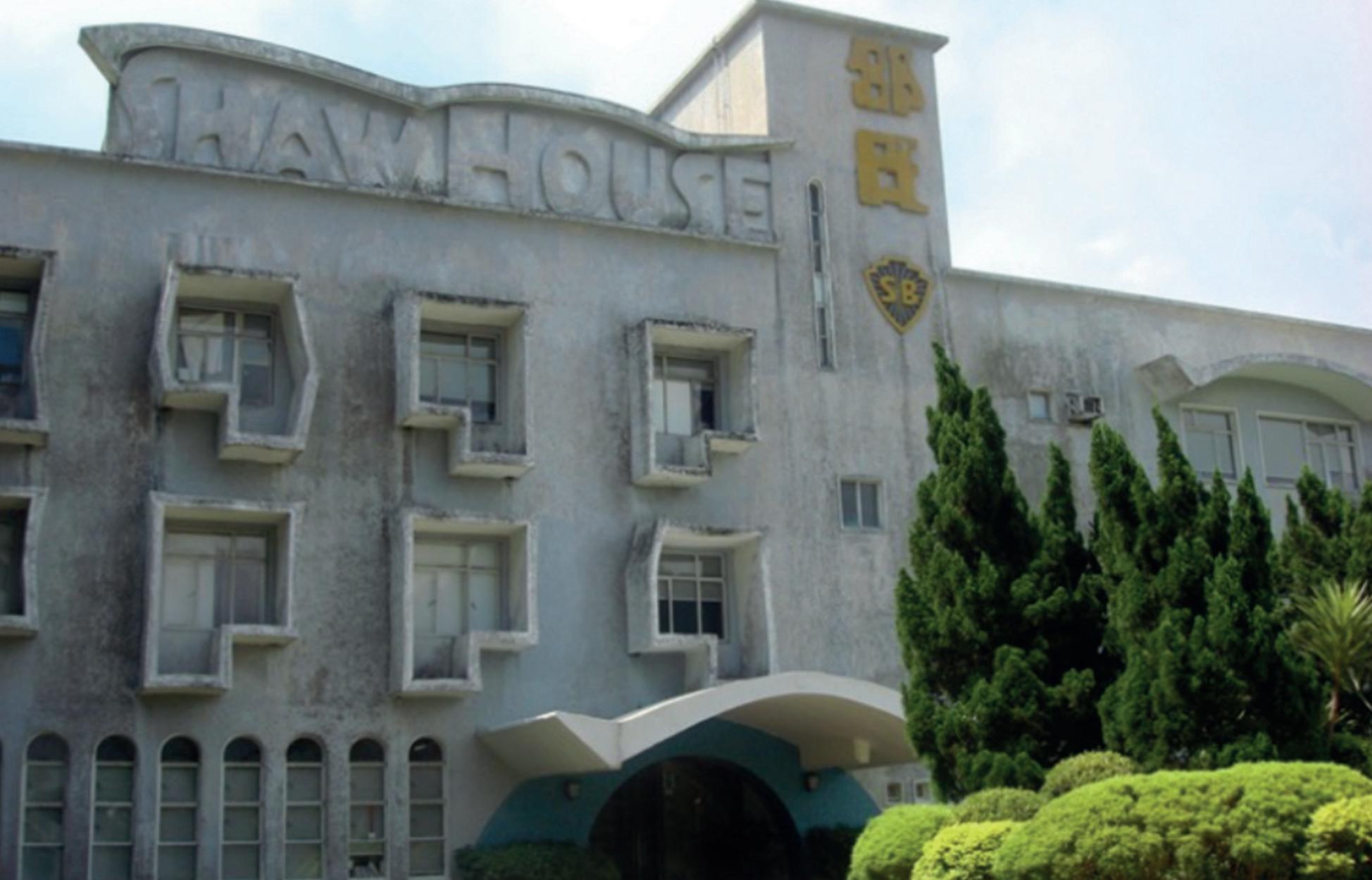

Studios
over one thousand films over the past sixty years.
Before joining Shaw Studios, Helena Young was the General Manager of The Grand and later The Metroplex, both situated in Hong Kong. The Grand was, at the time the largest multiplex cinema in HK (12 screens) and was the first to install Dolby Atmos in 2013 with the cinema serving as the premiere for HK’s first Dolby Atmos releases, Man of Steel and Pacific Rim.
Like The Grand, The Metroplex has always aimed to bring the best movie viewing experience to their audience. It is the
cinema with the greatest number of Dolby Atmos auditoriums (5 of the 9 screens at The Metroplex are equipped with Dolby Atmos). In addition to the newest blockbusters and mainstream movies, Helena also brought her audience a diversity of indie contents e.g. Sundance HK Film Festival (US), Annecy Film Festival (France), First Film Festival (China), film school student projects and much more. The cinema also supported community screenings for special-needs families and opened cinema tours to young students to promote a greater understanding of cinema operation and film appreciation.
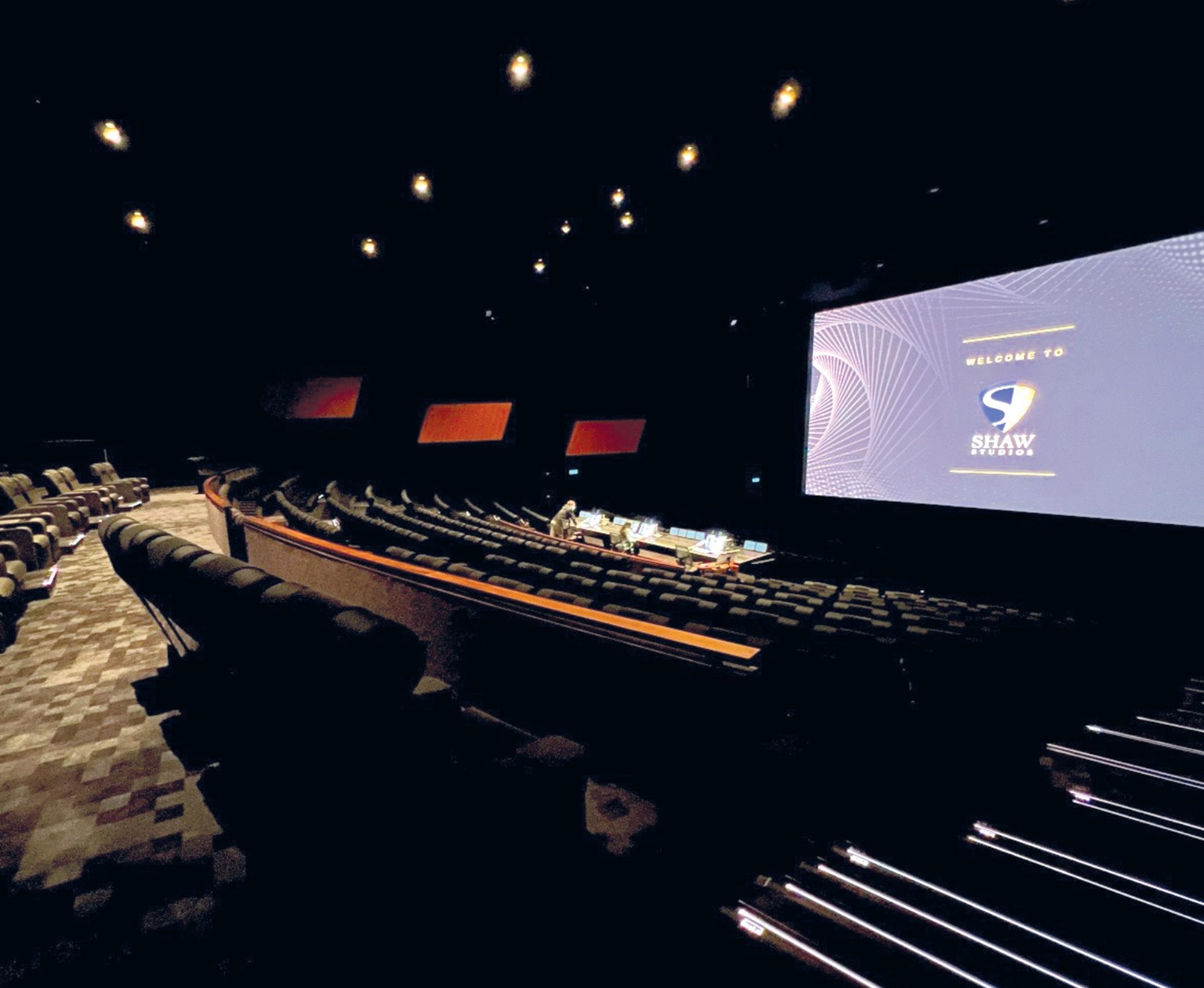
Wendy Nam has over 30 years of experience in the film and cinema industry. She was General Manager of Hong Kong’s United Artists Cinemas, which was the first multiplex cinema in Hong Kong and later became the largest cinema operator in HK.
After a successful spell with UAC, Wendy joined Shaw Studios to head its 35mm Film Laboratory. During the 2000’s, Wendy was Head of DI and the Film Remastering Lab. She spearheaded the remastering of 760 films in the Shaw Brothers film library over a six year period.

Shaw Studios was founded by Sir Run Run sixty years ago. At that time, it employed 1,200 film crew, 600 actors and many actresses. It was one of the largest private film studios in the world. It also directly employed film directors, scriptwriters, actors, cinematographers, production designers, props masters, technical crew, a film lab, etc.
International productions at Shaw Studios include: Ghost In The Shell, Thor: The Dark World, Shang-Chi And The Legend Of The Ten Rings.
Domestic Productions At Shaw Studios Include: Shock Wave 2, Lust Caution, Anita, Mama’s Affair, G Storm, Life Must Go On, Tales From The Occult, Zero To Hero, Ordinary Hero.
all of its pre-production, production and post-production and produced thousands of feature films; many of which are considered classics of Chinese cinema.
Shaw Studios moved to its current location in 2005. It covers an area of more than 10 acres, with 5 sound stages, 18 sound and picture editing suites, production offices and extensive workshop facilities. Shaw Studios upgrades its facilities to meet market needs from time-to-time and Shaw Theatre completed its latest upgrade in the summer of 2023.
The Shaw Theatre is a state-of-the-art Dolby Atmos mixing theatre, and one of the largest of its kind. The theatre is built on an innovative foundation comprising giant rubber bearings sandwiched between concrete slabs. To further minimise

extraneous noise and vibration, Shaw Theatre uses a “box in a box” design sharing no party walls with its neighbouring rooms. It allows the Film Director and his post-production crew to listen to their own mix in a “proper sized” cinema; the way that their audience will experience the film when it is released.
For audio post service it has a 5.1/7.1/Dolby Atmos mixing theatre for sound design, sound editing, audio mixing and also sound effects creation for feature films and TV. Shaw audio staff use an Avid S6 console to prepare for Dolby Atmos film mixing.
As with other post-production suites in the facility, Shaw Theatre is designed as a multi-purpose venue and can also be used as a colour-grading suite.
The theatre itself is situated at the end of a grand promenade. Adjourning this are a banquet hall, exhibition area and VIP lounge. It is an ideal venue for red carpet movie premieres, film award ceremonies, and their gala dinners or cocktail parties. The VIP lounge comes with green rooms, a private bar and pantry for the leading actors and actresses to rest with their selected guests or in a quiet space for media interviews.
It covers an area of more than 750sqm and has an auditorium seating capacity totalling 363 seats (345 Ferco Paragon 988 CB-CS) and 18 VIP reclinable seats at the back. The projector is a Barco 4K laser and sound is provided by 84 Meyer speakers (including VLFC – Very Low Frequency Controllers) with an 18m wide Stewart Screen completing the setup. www. shawstudios.hk

Vista Group’s newest innovation, the Vista Oneview mobile app, provides CEOs and their leaders with real-time movie, moviegoer and theatre data, with the ability to drive action and seize opportunities all from the palms of their hands.
July and August have been outstanding for our industry, with many markets and individual exhibitors riding the ‘Barbenheimer’ wave to record box office results. While this is welcome, the larger reality is that exhibitors must maximise operational efficiency whilst elevating guest experiences now more than ever. This is because even if many exhibitors hadn’t invested heavily in screens, seats, sound, F&B and other amenities before the pandemic, access to capital for such renovations is much harder to secure. In this new normal, success relies not just on having real-time data, but uniting it from disparate sources, and distilling it into insights that can be actioned on the go, from anywhere.
Vista Oneview was created for this reason. It was specifically
designed for exhibition CEOs and their leaders to provide measurable and actionable insights. This means that wherever they are, whatever the time, the Oneview app keeps these leaders connected, centred and in control of their business.

As we have told our CEO clients, “you are your company’s Tony Stark and we want the Oneview app to be your J.A.R.V.I.S”, referring to the AI system tasked with giving the leader of the Avengers the critical information he needs to emerge victorious at every critical moment.
Powered by the Vista Horizon, Vista’s web-based data warehouse, Oneview offers insights on everything from box office and admissions, market share, food and beverage performance, loyalty member activity and upcoming releases.
Oneview achieves this by being our first product to unite in the one place data from Vista Cinema, the world leading
cinema management software solution solutions; Movio Cinema EQ’s loyalty and membership data; and Numero’s aggregated box office results.
From a UX/UI perspective, we knew we had to bring these disparate data sources together, rather than have productspecific tabs, to allow the user to readily observe the insight at a per movie or per theatre level. As an example of this in action, in Oneview an exhibitor can see in the one data card the box office and admissions it earned for Barbie, tell whether they have achieved their regular market share for that movie, and then identify contactable loyalty members to drive their market share even higher.
We also wanted to provide the types of insights that could change an exhibitor’s fortunes. For this reason, we provided forward looking data with sufficient time to act upon it. One
way we have achieved this is by highlighting which forthcoming showtimes are at risk of selling out. With sharing capabilities via email, text, and corporate messaging apps, leaders can use Oneview to instruct their teams to adjust their programming.

Oneview is currently being piloted by a major international exhibitor and will be generally available by the end of September. Beyond that, we see the Oneview app as the apex layer of a data visualisation, business intelligence and decision support ecosystem across the various layers of a cinema exhibition business, from CEO to front-line management.
As cinema lovers, we believe that movies belong on the biggest screens possible. But the Oneview app demonstrates that the most powerful way to understand and direct your business is just to glance at the compact screen in the palm of your hand.

CineEurope is definitely one of my highlights of each year, and it is not just because it is held in Barcelona. For me, there is always a great combination of new products to see and look at on the trade show floor, people to meet and catch up with either in passing or at one of the many networking events, or the insightful discussions during the panel sessions, and that’s before all the studio presentations on upcoming releases. CineEurope 2023 was no exception to this experience, it was terrific.
There were a number of changes that had been made to make the event more sustainable. It was noticeable that Coca Cola really doubled down on their mission to reduce single-use materials providing clear recyclable cups for the Freestyle machines as well as the cups used for the presentations which after use were taken back, washed and then re-used. Even better was the thermal Costa Coffee cups provided on the tradeshow floor which required users to keep their cup for the week or hand it back to be washed before receiving another when using the heavily over-worked Costa Express machines.
The amount of waste that Coca Cola must have removed over the course of the week compared to previous years should have been substantial and they deserve so much credit for leading the way on this initiative and it’s great to see their partners including the team at Blue Stocking Partnership continuing to focus on Sustainability.
Through People: The biggest asset an organisation possesses is its people – they can be the ultimate competitive advantage. This session looked at the challenges that all companies face in attracting and keeping top talent, whilst simultaneously developing a high-performing culture. This session explained the launch of the UNIC People Programme and Advisory Board, intended to facilitate the required thinking and dialogue, as well as creating an appropriate response to these changes (more information can be found elsewhere in this edition). CineEurope Exec University Roundtable: kicked off with a keynote address from Film Director Juan Antonio Bayona. Two sessions then focussed on the industry and the requirement for cinema operators and indeed content providers to be responsive to shifting consumer demands.
Engaging Audiences & The Future of the Theatre Industry: Cinemas continue to adapt, invest and innovate to provide the most engaging experiences for cinema-goers. Together with partners in production and distribution and perhaps now more than ever, the sector must remain responsive to emerging trends and shifts in consumer behaviours.
Sustainability - Do Customers Care?: Climate change is now second only to war as the leading concern amongst citizens - it is followed by a majority of environmental issues. Koen Saels, European Sustainability Director Coca-Cola took the audience through these global insights and identified the opportunities for cinema operators to help consumers make the right choices.
As well as these sessions, there were also a number of technology-related seminar sessions held on the trade show floor focused on piracy, new technology, sustainable cinema design, data analytics and social media.

The trade show started to look a bit more like its old self in terms of size but still smaller highlighting that the industry is still recovering. From talking to those showcasing their products though, it was evident that the recovery is still
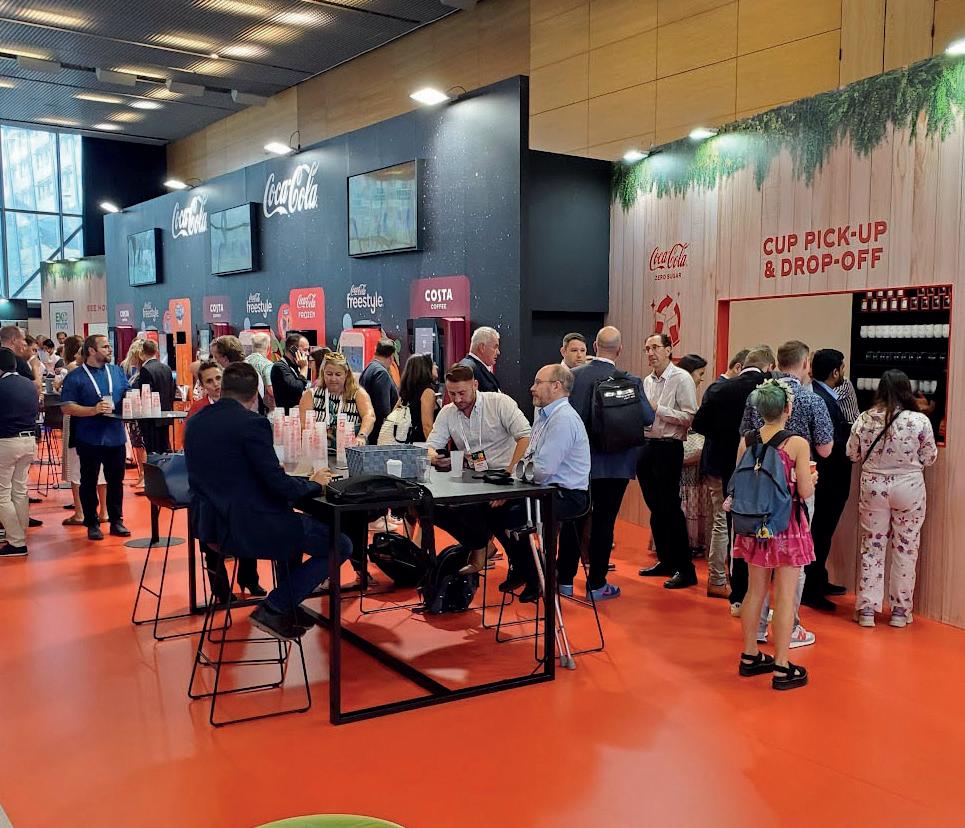
disjointed and that despite industry positivity, the money hasn’t necessarily filtered all the way down the food chain to equipment providers yet perhaps showcasing that exhibitors are still cautious to make large capital investments. As has become the norm, the largest number of stands on the trade floor remain those belonging to cinema seating companies, all of which had a large selection of their range of seats that are suitable for every cinema auditorium design and requirements.
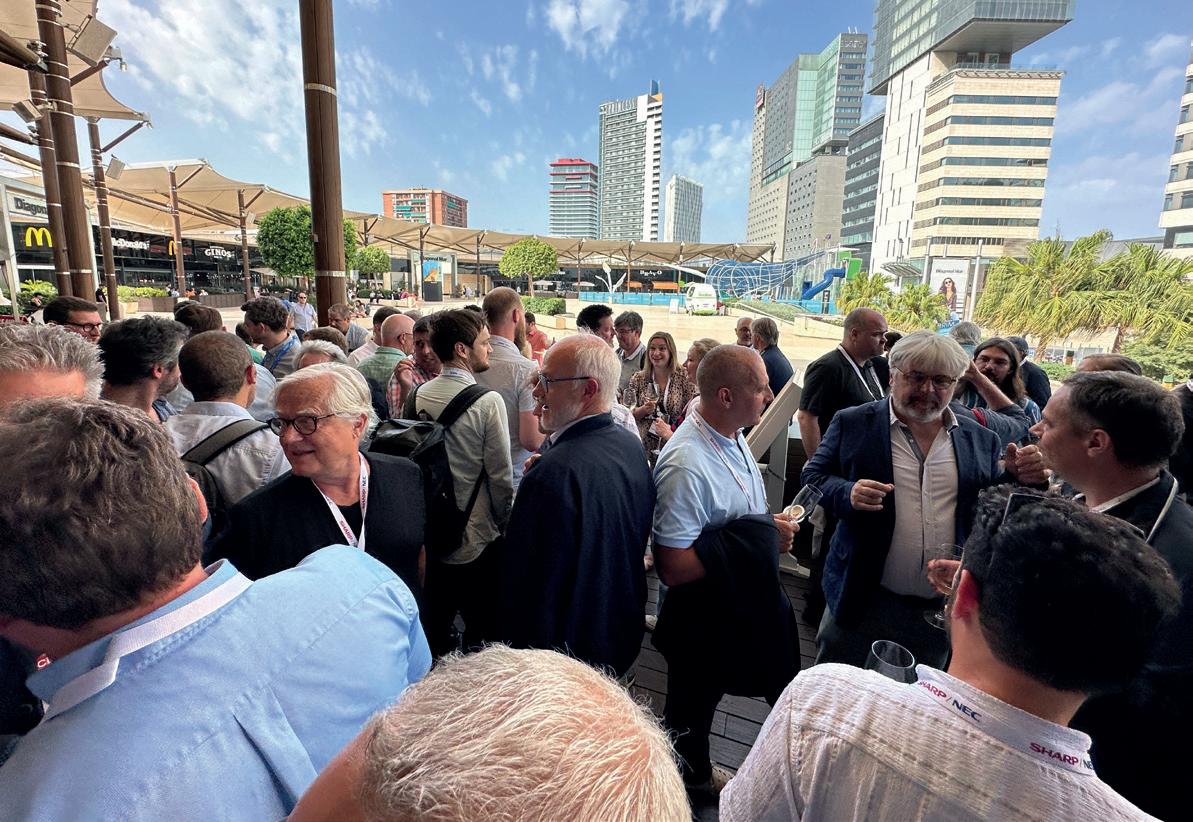
Beyond these, in the first floor demo suites, there were a few new products being demonstrated by a number of the different manufacturers including a range of laser projectors from all of the leading providers. There was also a range of non-projection equipment with highlights from Christie with their new Cinelife+ IMB-S4, Cinionic with their laser light upgrade options for xenon projectors, GDC with their PSD-SSD, Harkness with their new version of the Qalif Spectro, and DTS with DTS:X their new surround sound product.
The CCIB auditorium was once again adorned with all the latest and greatest in presentation technology from the likes of Cinionic, KCS and Harkness and it created a fantastic environment for studios ranging from the likes of Universal, Paramount and Warner Bros through to UniFrance and StudioCanal to showcase their upcoming slates. There was understandably significant excitement about the opportunities that this
diverse range of content will provide for exhibition to reach out to different audiences. It was also fascinating to see the use of a large-scale lobby experience deployed by Sony Pictures to promote Gran Turismo, a large multi-person simulation suite incorporating a range of cars fitted with D-Box seats where players could drive and compete. It provided a compelling space and seemed to attract a lot of attention throughout the show.
With all the Covid restrictions now completely removed and cinemas operating again at normal capacities, CineEurope was back to its old self and with a good number of people in attendance. It was also great to be part of a strong CTC presence with the majority of the leadership team at the show. For the first time, CTC had a trade show booth, we held our annual networking reception with more than 200 attendees and we distributed more than 600 copies of the magazine throughout the show. There may still be a number of challenges for the industry but it felt as though there was a desire to find the solutions. There was a lot of positivity around the whole event with lots of product being promised for the next few years. With a concerted effort across the sector, it feels like the industry will be able to return to and maybe even surpass pre-pandemic levels before too much longer.
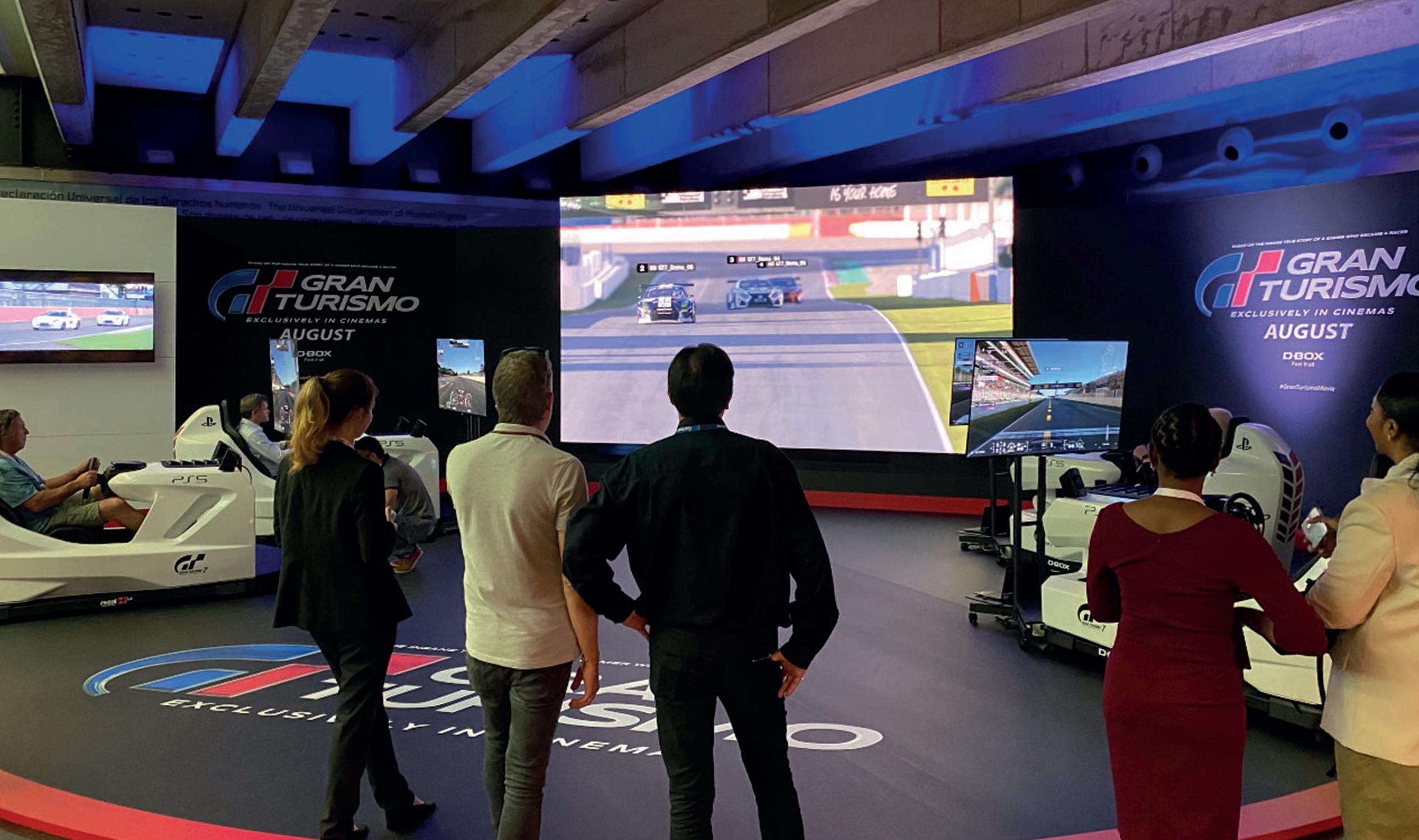
IN amongst all the positivity of the summer months and the various industry anniversaries before us, we almost missed that CTC has reached a milestone all of its own, being five years now since re-forming as an independent organisation dedicated to the cinema industry. Back in 2018, the team set out to broaden the international horizons of CTC recognising the industry’s requirement for impartial advice, education, training and support on all areas of cinema technology. During the past five years, the team has sought to create a body of resources (mostly housed on our web site) which are accessible to all regardless of technical proficiency.

Whilst ostensibly being a business “in start-up mode” for the majority of those five years and having zero revenue for two years due to the pandemic, the team has innovated, often being highly creative with incredibly limited budgets to achieve our goal of supporting the industry.
Despite various constraints, the team has managed to create more than fifteen hours of video content including two seasons of Tech Talks – our seminar on demand series, 11 episodes to date of our popular podcast “In The Pub with Mike Bradbury”, championed diversity and inclusion with Women in Cinema (through video and audio interviews) and panel discussions, produced more than a dozen technical white
Richard Mitchell (President), Graham Lodge (Vice President), Joseph Boutros, Mike Bradbury, Sandie Caffelle, Chris Connett, Mark Kendall, Peter Knight, Sarah Lewthwaite, Adam MacDonald, Saul Mahoney, Andre Mort, Markus Overath, David Pope, Toni Purvis, Ulf Qvicklund, Simon Tandy, Patrick von Sychowski, Kristina Warner, Paul Willmott
papers from topics as diverse as event cinema equipment choices through to a guide to holding outdoor screenings, created event cinema test materials suitable for broadcasters and exhibitors to work together to ensure presentation excellence ahead of performances, run multiple training courses aimed at educating cinema staff, hosted highly successful networking events including our annual meet and greet in Barcelona, delivered presentations throughout the world (and online) working with local industry organisations and taken ownership of Cinema Technology Magazine. Quite the catalogue of work!
Behind everything that we do at the Cinema Technology Community is a passion for ensuring that moviegoers have the best cinema experience possible.
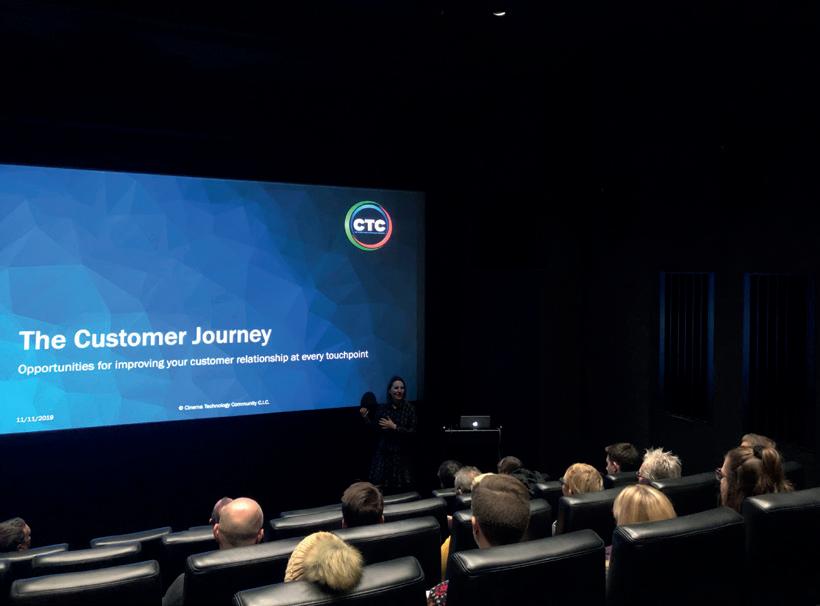

If you share that ambition, please join our community today by heading over to our site: cinema-technology.com
Whilst the team always knew there was significant demand for the content, none of us imagined the industry would engage in quite the way it has. When Covid hit, we took the difficult but logical decision to remove all barriers (including financial) to being part of our community to support the industry. Our membership has grown and grown and today CTC has just shy of 900 members in more than 80 countries around the world and we are indebted to our sponsors for continuing to support our work.
As the industry continues to evolve, you can be assured that CTC will remain by your side supporting, advising and educating with more high quality and accessible content. We have ambitious plans for 2024 and beyond building on the incredible platform we’ve created.
CinemaNext can help you to extend the lifetime of your projector by upgrading your lamp components to a laser projector
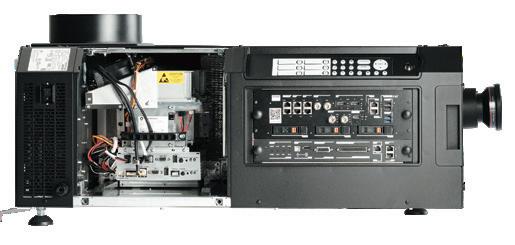
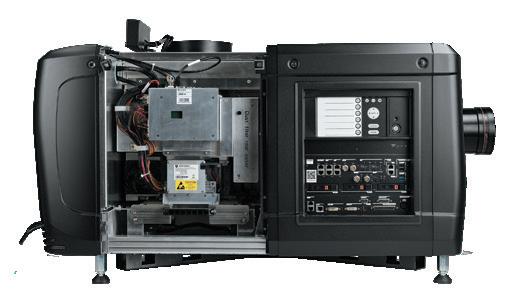
Six reasons to upgrade your existing Barco Series 2 projectors with Cinionic’s Laser Light Upgrade kits:
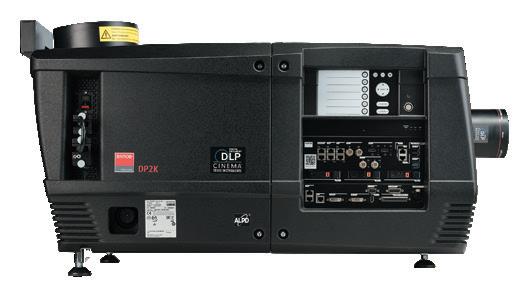
better image quality improved brightness, colour, contrast, uniformity & stability
financial flexibility possibility to personalize your financial plan
HOW IT WORKS:
no worries 100% lamp free
prolong projector lifetime warranty extension available environmentally friendly save up to 70% on energy and reduce waste
cost savings via reduced energy consumption and decreased use of HVAC
1. Firstly, we will discuss with you to make sure an LLU (Laser Light Upgrade) would be a suitable solution for your existing Barco equipment. We can also use our OPEX calculator to approximate your potential cost savings over any given timeframe.
2. We then survey your existing projector(s) and organise a health check to make sure your model(s) can be upgraded, and if your projector warranty can be extended by installing an LLU. At this stage, we can also offer a light cleanse, which in most cases will increase your projector’s longevity even further.
3. Once the installation has been agreed, our certified technicians will attend to replace all Xenon lamp components, including the lamp house, power supplies, and spark generator by a laser source, laser driver modules, and dedicated laser cooling for up to 70% in annual energy savings.
4. We can also review your current server and propose an upgrade (not essential and may not be required), for better integration with content management and future proofing your system for the coming years.
Acouple of months ago film professionals from across Europe and beyond flocked to Barcelona for CineEurope 2023, with over 3,500 accredited participants from over 70 countries. Delegates were excited to attend the convention to discover upcoming films, learn about new cinema technologies and attend seminars to hear expert opinions on the latest trends in the cinema industry. Panels offered insightful discussions on upcoming technological innovations, the growing investments in premium experiences, and the increased focus on sustainability issues. All expressed their unwavering confidence in the Big Screen experience.
This year’s edition of CineEurope was boosted by positive box office numbers for the first half of 2023. Indeed, according to Gower Street Analytics, in June the global box office generated $2.9 billion, outperforming the levels of the two prior months (+6 per cent compared to May and +3 per cent vs April). This helped Q2 2023 reach $8.6 billion, which was the best quarterly result since 2019, surpassing 2023’s first quarter by 10 per cent. In the EMEA region the Q2 box office was only 10 per cent below the 2017-2019 average. Among the best performing territories in Europe there is the Netherlands, with a box office increase of 2 per cent in the first half of 2023 against the 2017-2019 average and up 3.3 per cent versus Q1 2023. Germany reached the same level of revenue as the average H1 of 2017 to 2019, with Q2 of 2023 up 10 per cent compared to pre-pandemic levels. Italy, which was among the countries struggling the most to recover last year, saw its box office results improve to being above the pre-pandemic average in May and June. Poland continued to perform well, with a Q2 box office also mirroring pre-pandemic results and admissions only 7.2 per cent below the pre-pandemic average. France saw a strong cinema attendance in April and May, positively impacting the whole quarter which finished just 1.7 per
www.uniccinemas.org.
cent below the 2017 to 2019 average. Avatar: The Way of Water, Super Mario The Movie, The Little Mermaid and Spider-Man: Across the Spider-Verse – among others – delivered at the box office in the first half of 2023 and heading in to the summer, UNIC remained confident that with Mission Impossible: Dead Reckoning Part One, Barbie and Oppenheimer it would inject further positivity in to the box office across Europe which would then be backed up by the likes of Dune II and Napoleon in the second half of the year.
Additional facts and figures of 2022 and the first months of 2023 are available in the UNIC Annual Report 2023, published during CineEurope.
CineEurope 2023 also coincided with the launch of the 7th edition of the UNIC Women’s Cinema Leadership programme, the 12-month cross-sector, pan-European mentoring scheme for women in cinema exhibition. We welcomed 12 new pairs of mentors and mentees, who met for the first time and shared their goals for the upcoming months. Furthermore, a new initiative kicked off in Barcelona: the UNIC People Programme, which aims to help the cinema industry maintain its position as an employer of choice. The programme strives to ensure that the industry remains well-placed to attract and retain top talent. With new challenges emerging for cinemas after the pandemic, the cinema industry must adapt to the ever-changing landscape of today’s World.
We are now getting ready for UNIC’s main event in BrusselsUNIC’s Cinema Days. The conference, which will take place on the 19-20 October 2023, will once again welcome an exclusive group of senior executives and key figures from across the European and international cinema landscape for an exciting two days of debates, workshops and social activities. Stay tuned!


After a pandemic induced hiatus, July’s 2023 ICTA Convention was another resounding success. This year’s convention took place in the heart of the film industry in Los Angeles. Programming included a look at the past and glimpses into the future of sight and sound technology for cinema. Session topics included a panel discussion on the ‘Audio Challenges of Direct View Screen Applications in Cinema’, ‘Developments in Holographic Display Technology’ and a visit to XR Studios, a virtual production facility. Attendees were also treated to special presentations by industry luminaries Ioan Allen and Tomlinson Holman, providing fascinating historical perspectives on cinema sound and the technology used to deliver it.
Our annual convention is also the forum for several prestigious ICTA awards. ICTA’s annual Allen Award, named in honor of Dolby and cinema audio legend Ioan Allen, is given out each year to an ICTA member for their outstanding contribution to ICTA and the cinema industry at large. This year, we recognized Susie Beiersdorf of Lens to Screen Consulting. Susie has given many years of dedicated service to ICTA as a member of our board of directors, representing ICTA on InterSociety/ISDCF and most recently co-organizing (along with Beth Figge from Dolby) this year’s Los Angeles Convention.
The Teddy Award is presented annually by the active dealer membership of the ICTA to the manufacturer member who most closely exemplifies the progressive principals of product development and provides the dealers with service and up-todate technical and sales information. This year’s winner was Dolby Laboratories, whose contribution to the cinema industry and its dealers continues to drive forward cinema technology and the moviegoing experience.
The Rodney Award was created to recognize the outstanding ICTA Dealer. The criteria for selection are: the dealer should be aggressive in marketing and sales; should maintain an adequate inventory; provide quality installation; provide quality after-sales service; and should have a good product and application knowledge. This year’s recipient was Bobby Franklin of Franklin Designs.
In response to overwhelming positive feedback from our inaugural educational session, “The Fundamentals of Presentation Technology”, which took place in Las Vegas at CinemaCon last April, we’ve decided to take the show on the road. We will be offering the course at several other upcoming industry gatherings and regional cinema events, where we plan to share fundamental concepts about cinema sound, projection, networks, and maintenance. The 2-hour class is designed as a crash course for non-technical positions within cinema exhibition.
The ICTA partnership with NATO’s Cinema Foundation continues to grow stronger. Our January 2024 Los Angeles Seminar Series will once again be held at the Hilton Los Angeles/Universal City conducted in partnership with the Cinema Foundation, which will expose our strong programming to larger audiences within the exhibition community. We were also proud to support the Cinema Foundation’s efforts in National Cinema Day, an annual event which serves the industry with special promotions, discounts, and other incentives to preserve moviegoing as the number one form of out-of-home entertainment.
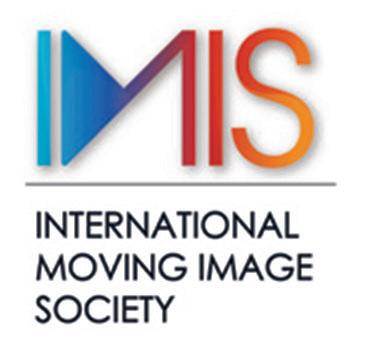
Greetings to all CTC magazine readers and IMIS/BKSTS members.
In our last update we announced the launch of our new website at www. movingimagesociety.net I hope by now you have had a chance to visit the site and explore our immense archive of articles and features about past and contemporary cinema. We have recently added some further new features to facilitate knowledge sharing and expanded our range of products in the IMIS shop.
Orders keep coming in from around the world for our iconic BKSTS Cinema Heritage Wallcharts. The Widescreen format chart has sold out and is currently being reprinted. The 70mm IMAX film print of “Oppenheimer” at the iconic BFI IMAX Cinema played to sold out houses with midnight and even 4am screenings. Looking down from the walls at all that activity are examples of the legendary BKSTS wallcharts. Imbue your cinema office, technical area, corridor, foyer or cafe with an authentic sense of cinema heritage with these famous wall charts framed and mounted on the wall.

Elliot Hasler, Director of Independent Feature “Vindication Swim” gave an IMIS sponsored talk at Bournemouth University. on Thursday 18 May as part of the Bournemouth University (BU) Festival of Media Production. BU is an IMIS Accredited
Institution. Elliott, a young British independent writer/director and IMIS member, gave a presentation about the making of “Vindication Swim” which depicts the incredible story of Mercedes Gleitze, the first British woman to swim the English Channel. He was joined by actor John Locke to take questions from the audience. See the pair on location in the picture above. A recording of the presentation will soon be available in our member’s section.
Up and coming events include a presentation with Q&A by Aidan McCarthy, an award winning sound editor who among his many credits worked on Sir David Attenborough’s, ‘Are We Changing Planet Earth?’. In addition, we have in the pipeline a presentation by Adele Fletcher who won a 2023 BAFTA for postproduction sound in the Television Craft, Sound Fiction category for HBO’s House of the Dragon.
IIn 2018, the UK Cinema Association launched its Technology Challenge Fund, tasked with exploring new ways of delivering ‘closed captions’ in cinemas to those who need them through some form of personalised device, the overall aim being to widen the range of films available to customers with hearing loss, allowing them to enjoy the big screen experience with friends and family at more regular and desirable times.
After a number of rounds of funding, the project - steered
by a panel of experts from across the industry and a user group of cinema-goers with hearing loss – ultimately settled on a ‘smart’ eyewear solution developed by the National Theatre, where captions synced to the film are played across the lenses of a pair of glasses, allowing the customer to view the film and the captions simultaneously without having to alter their sight-line or switch between different screens.
Despite the success and speed with which the project initially moved forward, culminating in a ‘live’ trial at the BFI Short Film Festival in London at the beginning of 2020, the project was unfortunately put on hold due to the impacts of the pandemic and it was not until early 2022 that this work could be picked up again.
However, that same disruption meant that the National Theatre was not at that point in a position to continue to support the project. As a result of which the UK Cinema Association began working with the newly-formed company Built For Good Technology, comprising many of the same team involved in the original project and therefore already aware of the key challenges and opportunities a personalised smart glasses solution might present to the cinema sector.
Throughout last year, the Association was able to support further progress of the solution, resulting in the development of a new approach with new software capable of working in conjunction with a new iteration of the smart glasses, offering a more sophisticated and compatible solution cinemas might consider adopting once available.
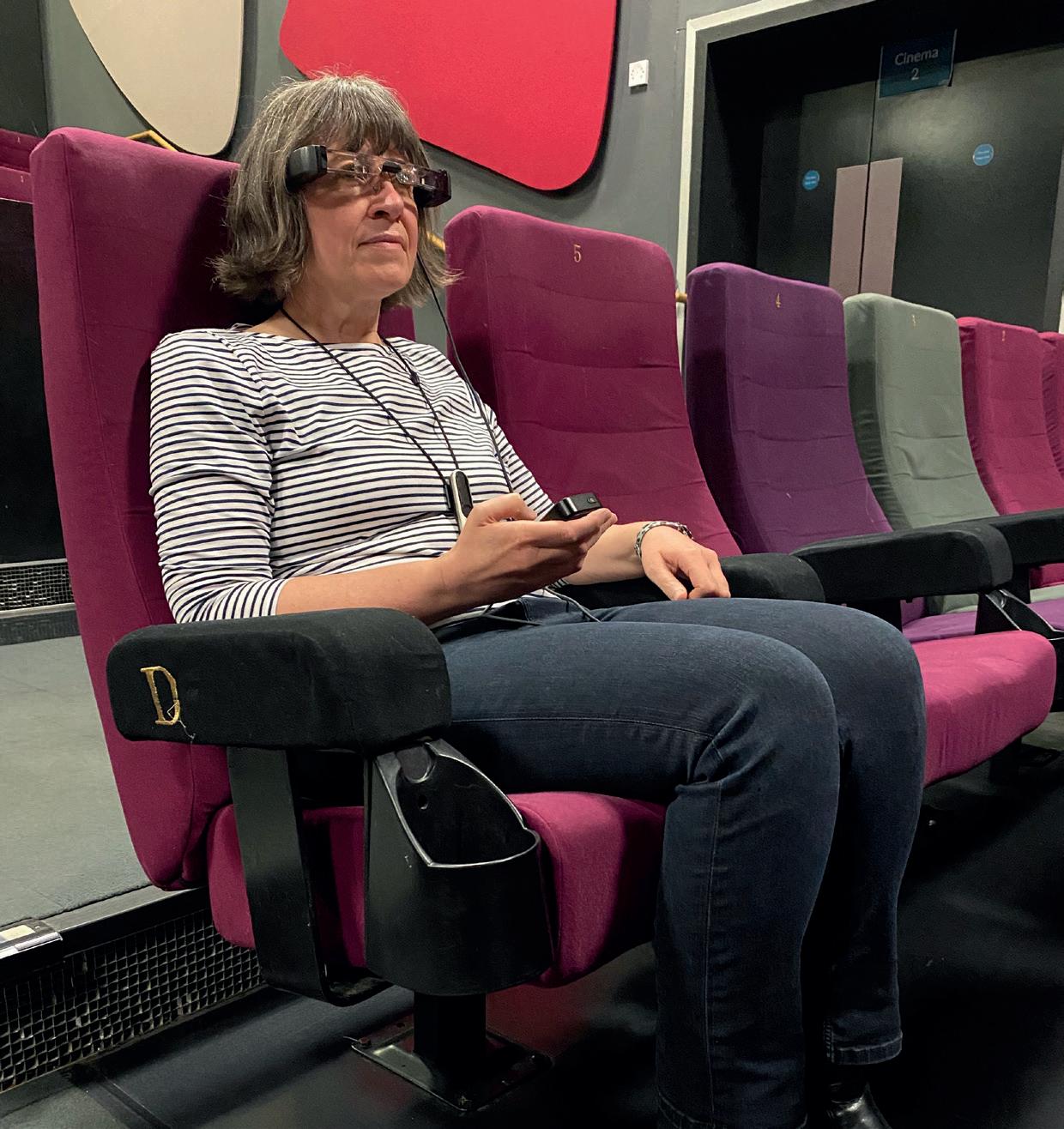
‘The Technology’ – The ‘smart’ glasses that have been used and tested throughout each stage of development are an ‘off the
shelf’ product produced by the technology company Epson. These have a range of existing functions used in a number of other industries, such as medicine and dentistry. However, the new iteration of these glasses - which were tweaked based on some of the project’s feedback are now more suited to the cinema environment. They therefore offer a more customerfriendly solution that is lighter and more amenable.
During 2023, the project’s progress has accelerated with the team at Built For Good Technology testing the solution in a number of cinema environments including the QUAD cinema in Derby and the BFI Southbank in London, whilst also regularly seeking the thoughts and feedback from a group of hard of hearing and deaf cinema-goers through a number of live in-cinema demos.

This feedback has been overwhelmingly enthusiastic and positive, one of the group said –
“I am used to reading subtitles on films and TV, so I found it very easy to follow the captions. The additional benefits of being able to change font size and colour meant that the subtitles could be adjusted perfectly (which is not usually the case on a subtitled film). It felt good to be in control of the subtitles!”
More recently, the new solution was also demonstrated to the expert panel overseeing the project, the Association’s Executive Board and its long-standing Disability Working Group, all of whom seemed enthused by the progress and solution whilst also offering some constructive and pragmatic feedback which has been taken on board and will inform some of the remaining development as we look at the ‘customer journey’ and booking processes.
Over the coming months, discussions are planned with both Epson and Built For Good Technology on the costs of the solution and different financial modelling which might suit the cinema sector, as well as on how the solution might be coherently promoted and effectively rolled-out in cinemas and to the deaf and hard of hearing audience.
It is anticipated that the solution will be presented to the wider sector and the Association’s full membership towards the end of the year, following which it is hoped cinemas might consider adopting this smart adaptive technology, which should provide an alternative method of accessing and enjoying captions in cinemas for those who might benefit.


CT: Please introduce yourself and tell us about your background?
I’m Theresa English, Principal with TK Architects and a licensed Architect in 18 states, currently. I also am a LEED Accredited Professional for Building Design and Construction. I’ve been part of TK for 17 years.

CT: Who are TK Architects?
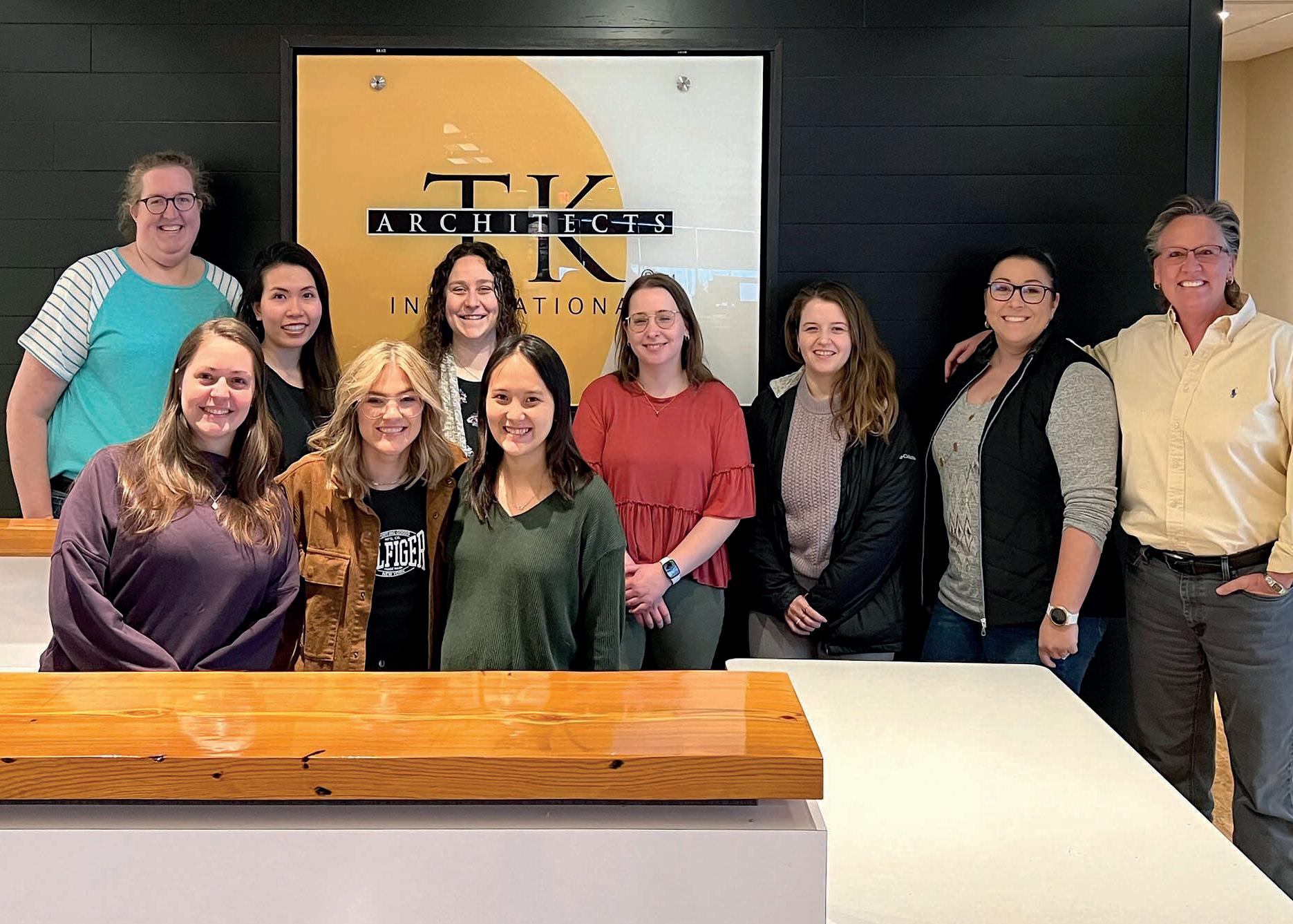
TK Architects International was founded in 1981 with a focus on understanding our client’s vision and discovering, developing, and delivering each project’s unique character. As a full-service firm, TK Architects International offers all professional design services inhouse to simplify and streamline coordination, including:
Architecture
Interior Design
Concept Design
Structural Engineering
Mechanical, Electrical and Plumbing Engineering
Graphic Design and Branding
TK Architects International is recognized nationally and internationally as a leader in cinema,
entertainment, food and beverage and retail design. The services include design and engineering of cinemas with traditional and large format screens, VIP seating, bars/ lounges, cafes/restaurants, entertainment centers, bowling and arcades, retail and other multi-use spaces.
CT: Tell us about your role with TK Architects and how it’s evolved?
I focus on client management, project management and marketing. When I started I had so much to learn about the cinema industry and now I’m the one sharing those ideas and knowledge with new staff.
CT: What does your day to day look like?
Most days include working with the team members on the projects and clients I’m involved with managing. That usually involves some calls with the clients, whether that’s traditional or a virtual meeting, coordinating with vendors and pursuing new work.
CT: How has the evolution of technology in the AEC industry enhanced the work you do?
Technology is a tool we can use to better articulate our ideas to clients. Certainly, how we think about sight lines for guests and projectors have changed completely through the use of technology. For clients that are not familiar with reading architectural plans, it helps them experience and perceive the space prior to construction starting. We can incorporate vendors information into the project so that owners have a one stop place for their information.
CT: Given the technology capabilities architects now possess, do exhibitors expect more?
We can tailor projects to the individual client needs and expectations, technology like many things is a tool that we use to help meet those expectations but communication is probably the most important tool.
“Technology is a tool we can use to better articulate ideas to our clients. ”Theresa English with Tamra Knapp (Senior Principal) and the team celebrating International Women’s Day.
CT: There is a significant focus on sustainability and reducing carbon footprint currently. How much are you able to capture in the design phase?
Understanding the clients goals in relation to sustainability are where we start and then tie that into what the jurisdictional requirements are and incorporate both of those aspects as early as possible in the design.
We definitely are seeing the jurisdictional
requirements increase and expect that will accelerate for both new and existing buildings.
CT: The move to FECs appears to be gathering momentum, what challenges do these present to an architect?
For new construction in the US, there are building code differences that are pretty substantially different for spaces that are cinema vs bowling/arcade or bar. Cinema if the conditions are right, can be unlimited area.

That section of the code does not exist for buildings with bowling or arcade. For renovation within an existing cinema
converting to an FEC you have different challenges tied into columns or demising walls/bracing that force you to fit elements into spaces in ways that would not be ideal in new construction. Thinking about volumes and whether you keep or demolish a mezzanine, for example, can create both opportunities and challenges.
CT: What’s your favourite thing about working in the industry?
The camaraderie and joy with which people approach the industry! Collaborating on projects with colleagues, friends and clients that bring great guest experiences to moviegoers is fantastic!
“Understanding the client goals in relation to sustainability are where we start... ”DongGuan Yitian Cinema, (Guandong, China).
With nearly 900 members in over 80 countries, Cinema Technology Community (CTC) is the world’s leading independent, not-for-profit trade organisation providing valuable educational resources to the global cinema industr y
With a highly engaged global community and a regular stream of content designed to help the industr y improve the movie-going experience for consumers, CTC is the go to place for cinema industr y executives
And what’s more, it’s completely free to join because, at CTC we believe that the industr y is stronger and better when we all learn and share together, so we’ve removed the biggest barrier

